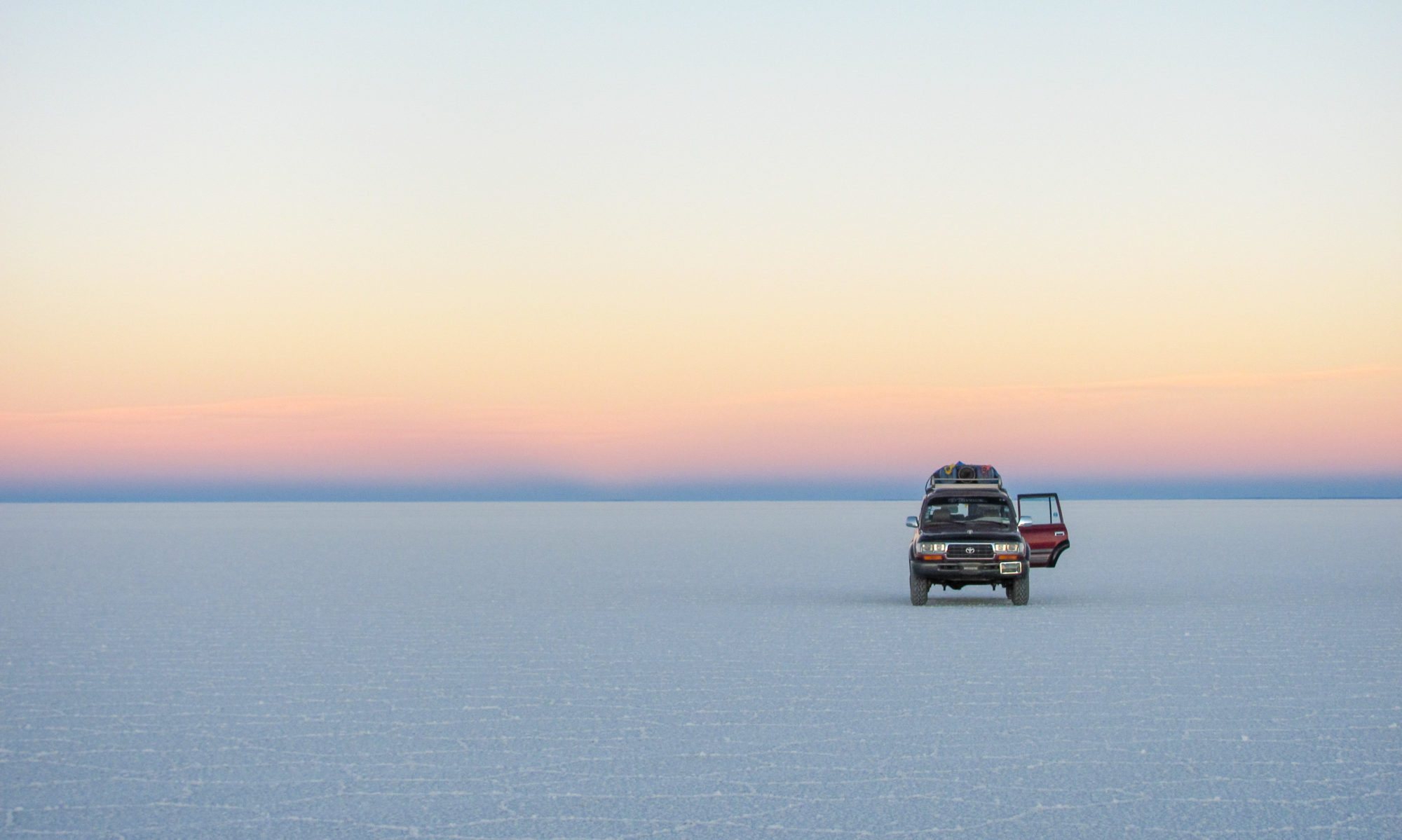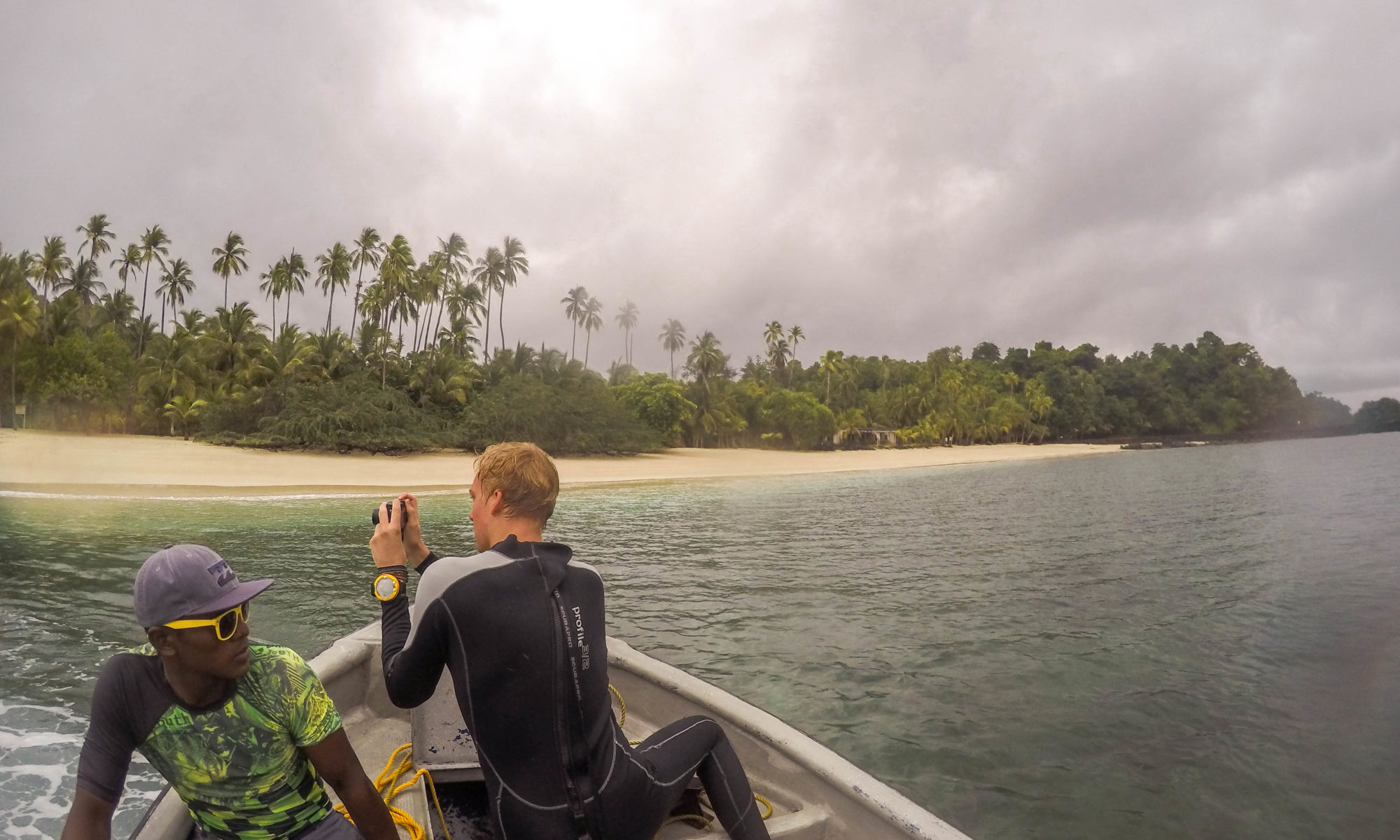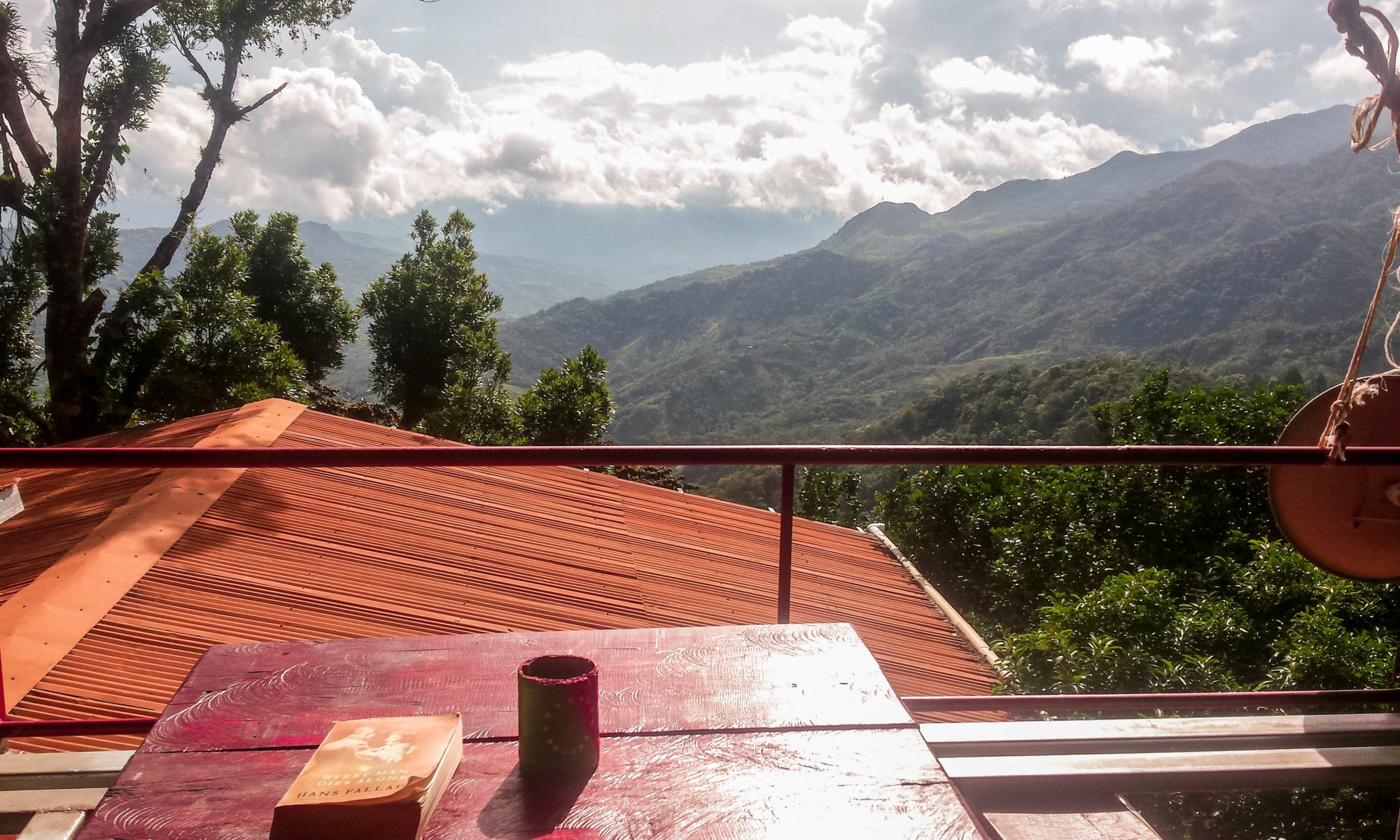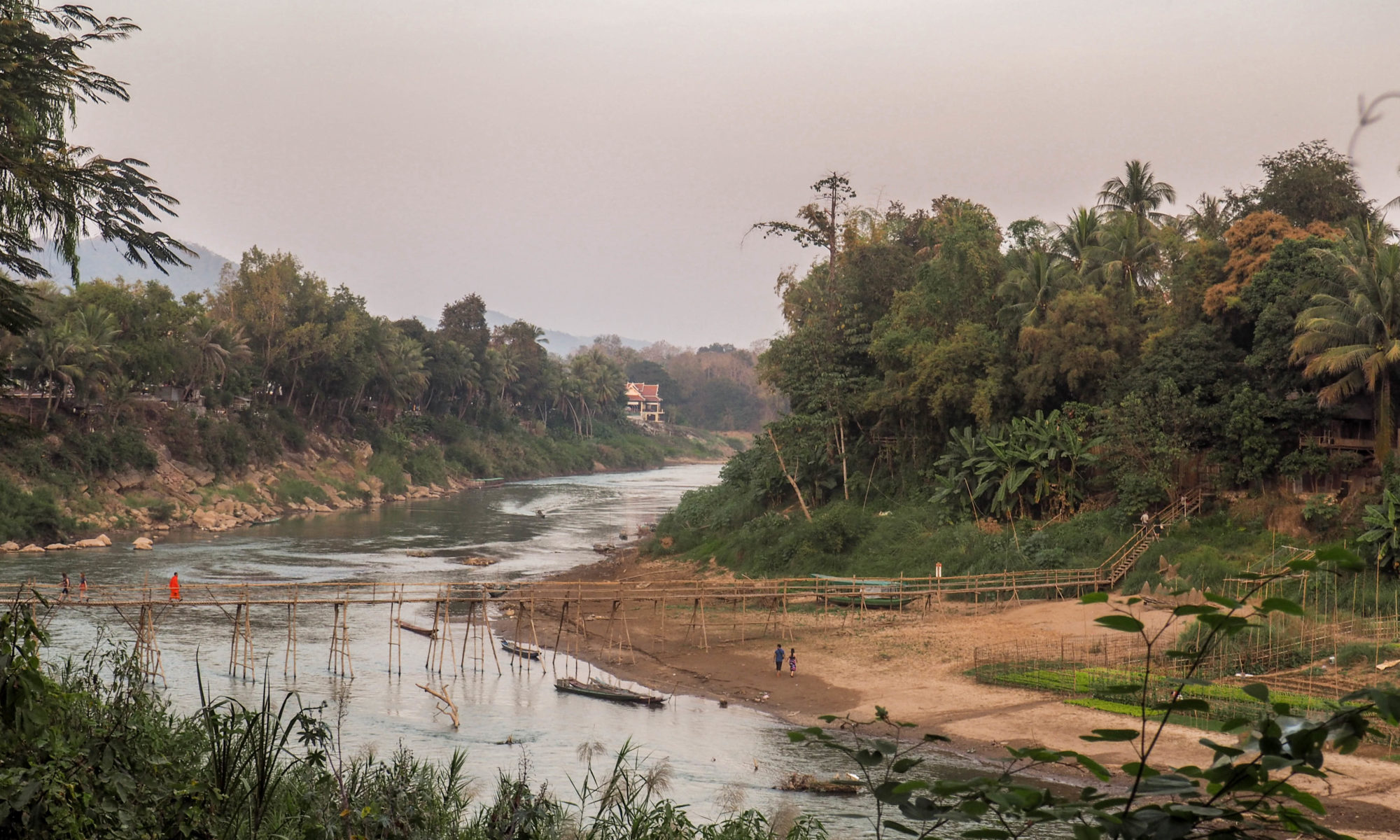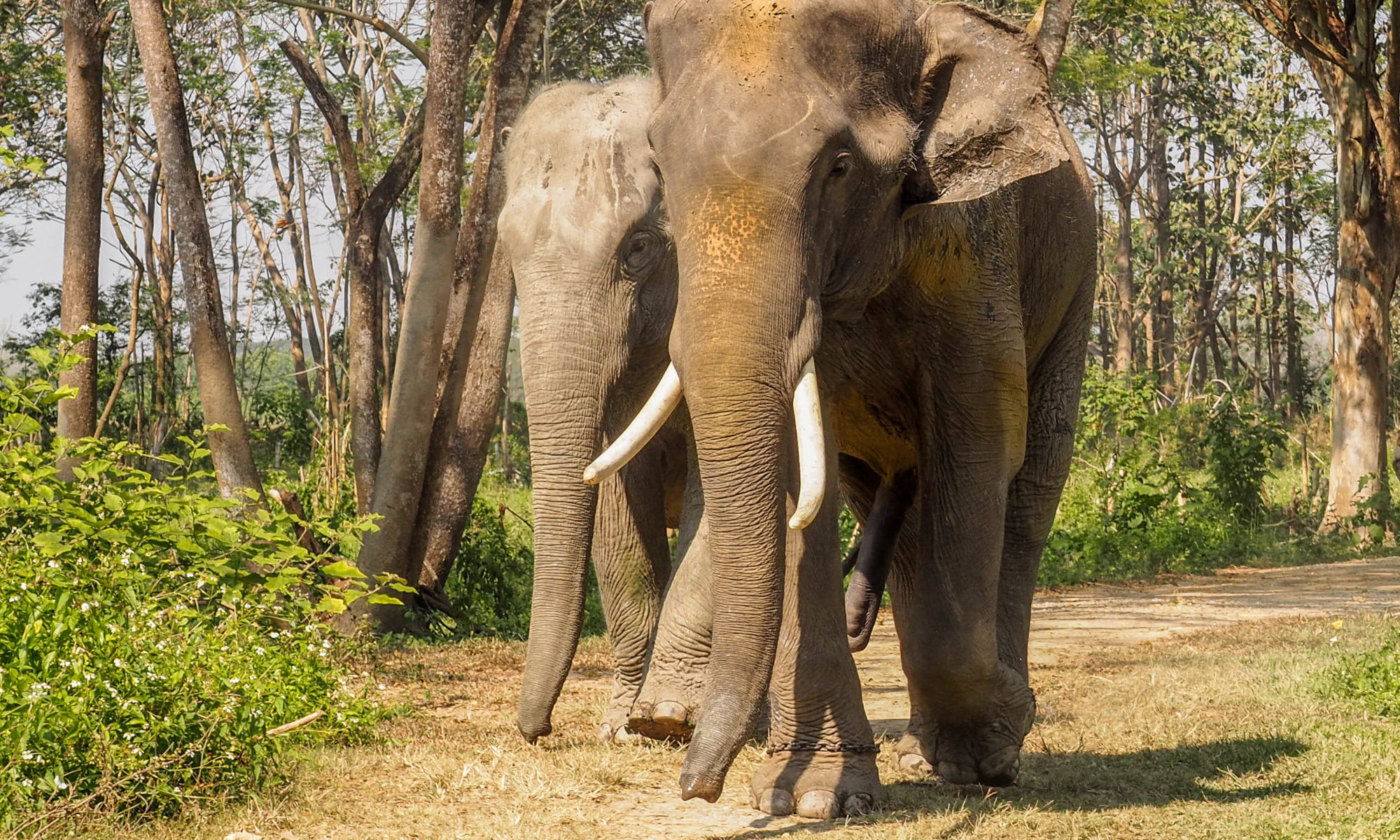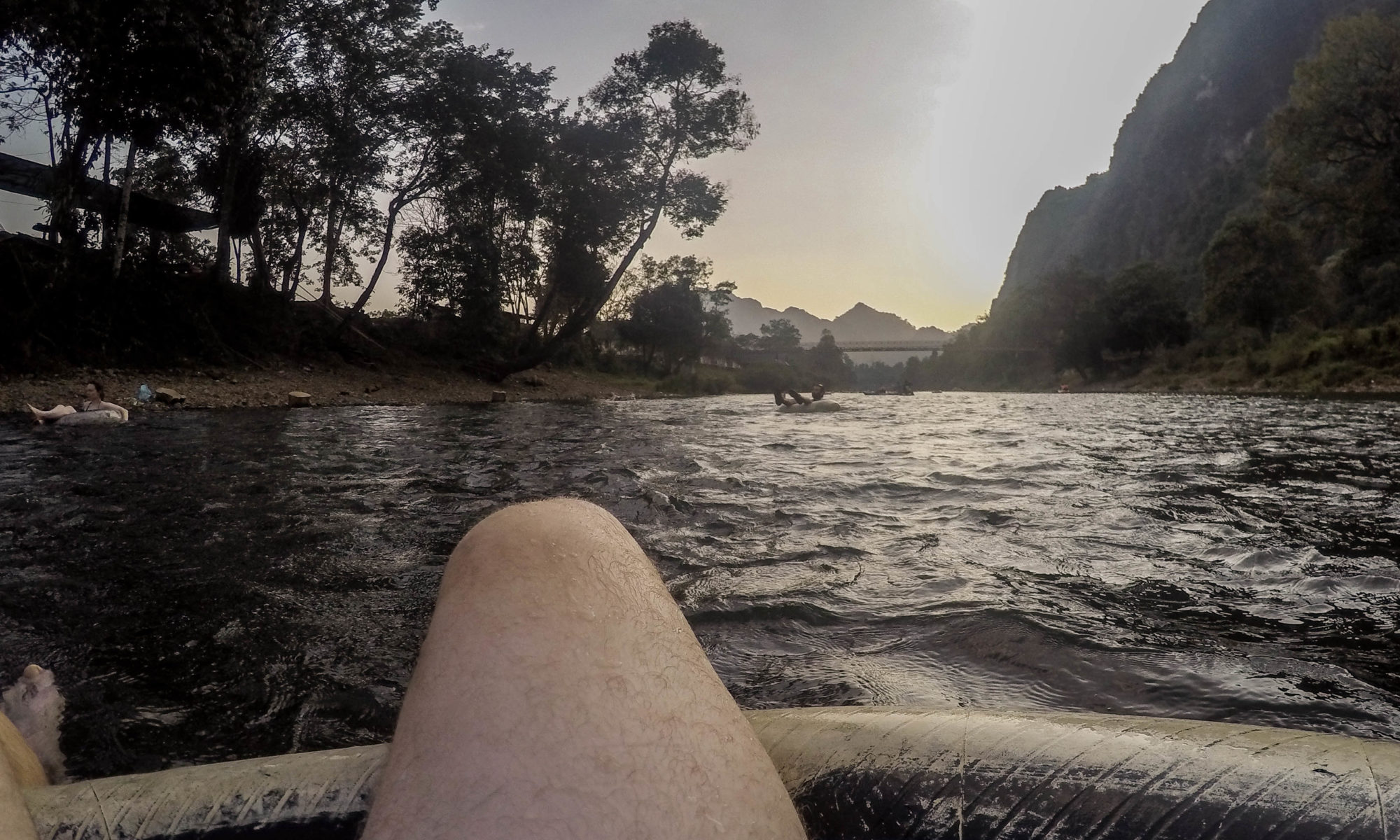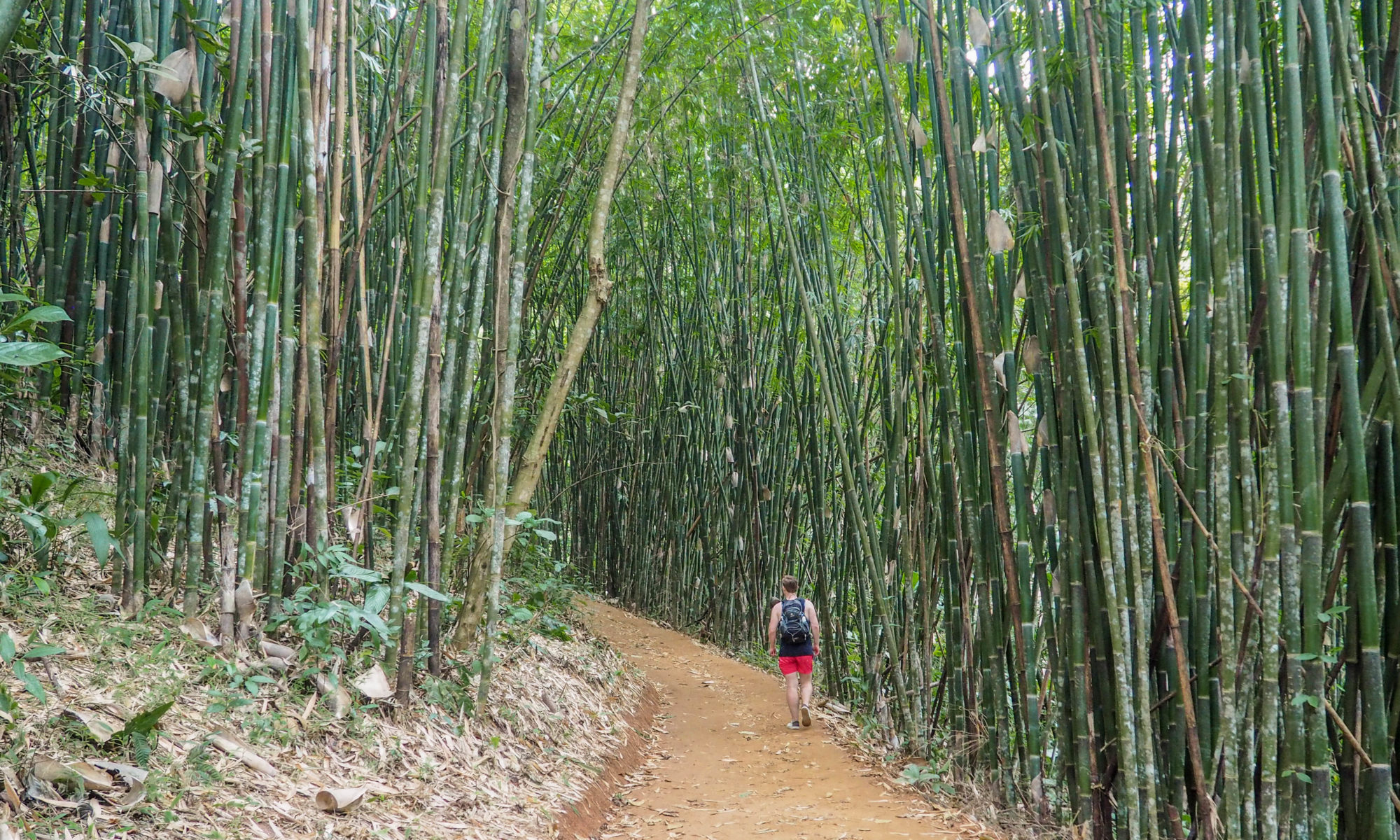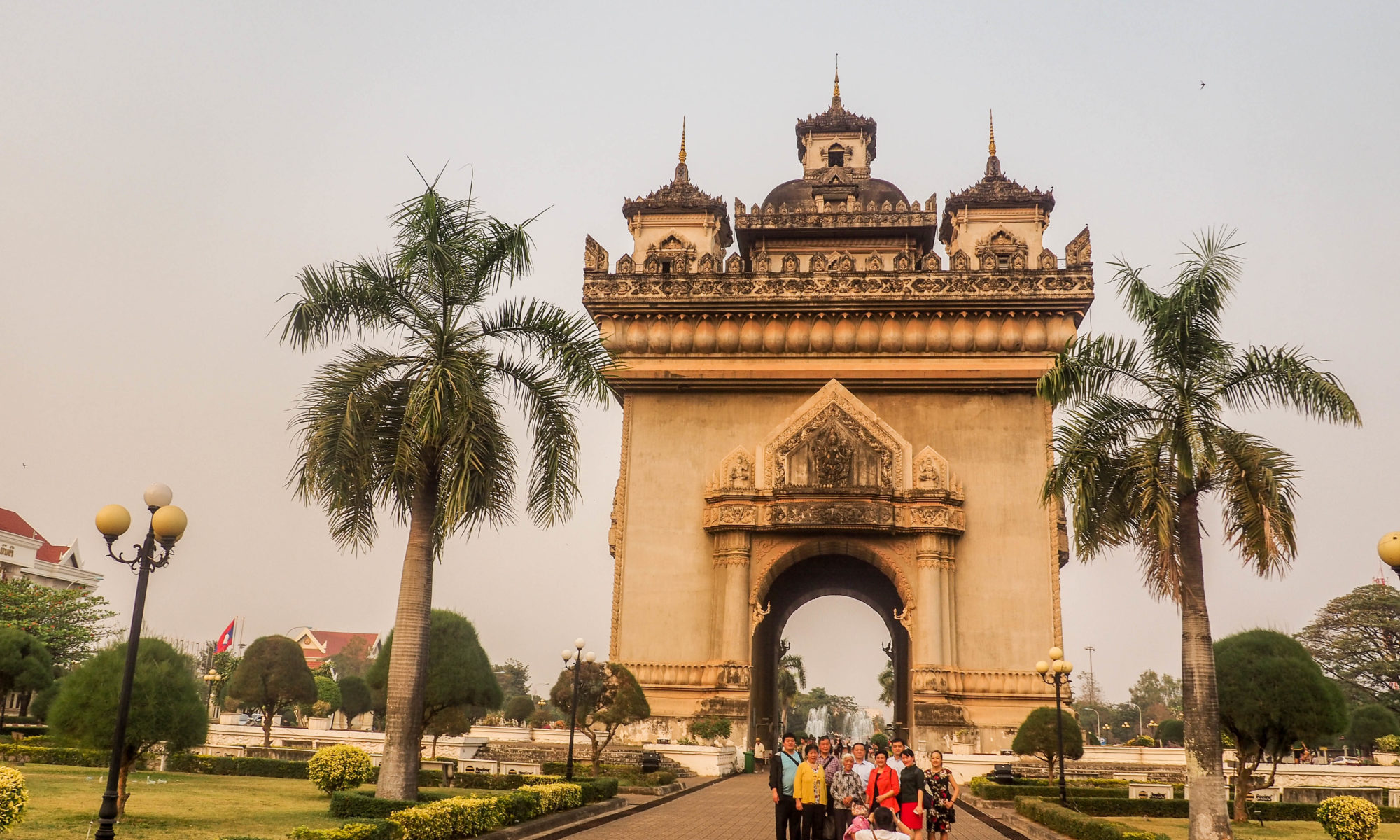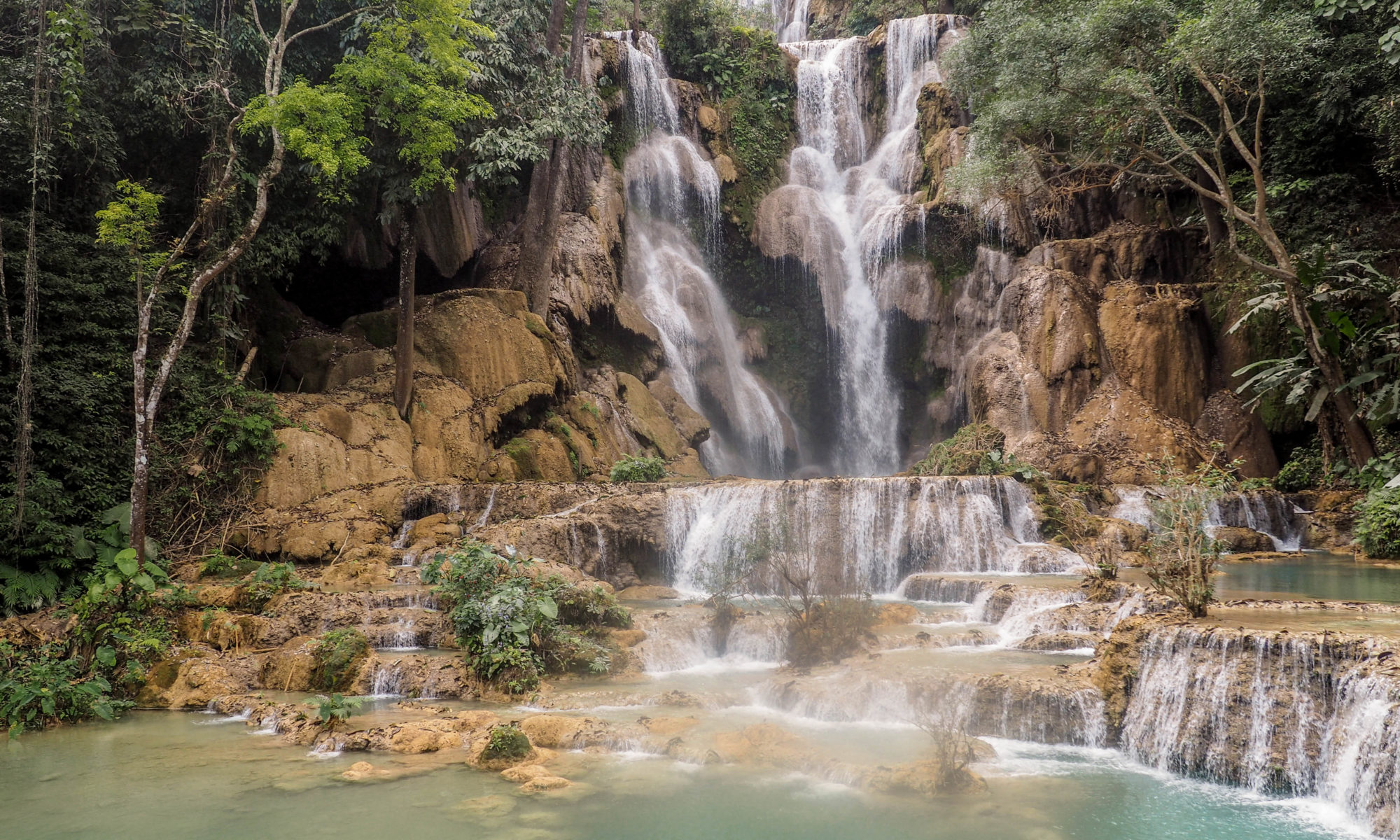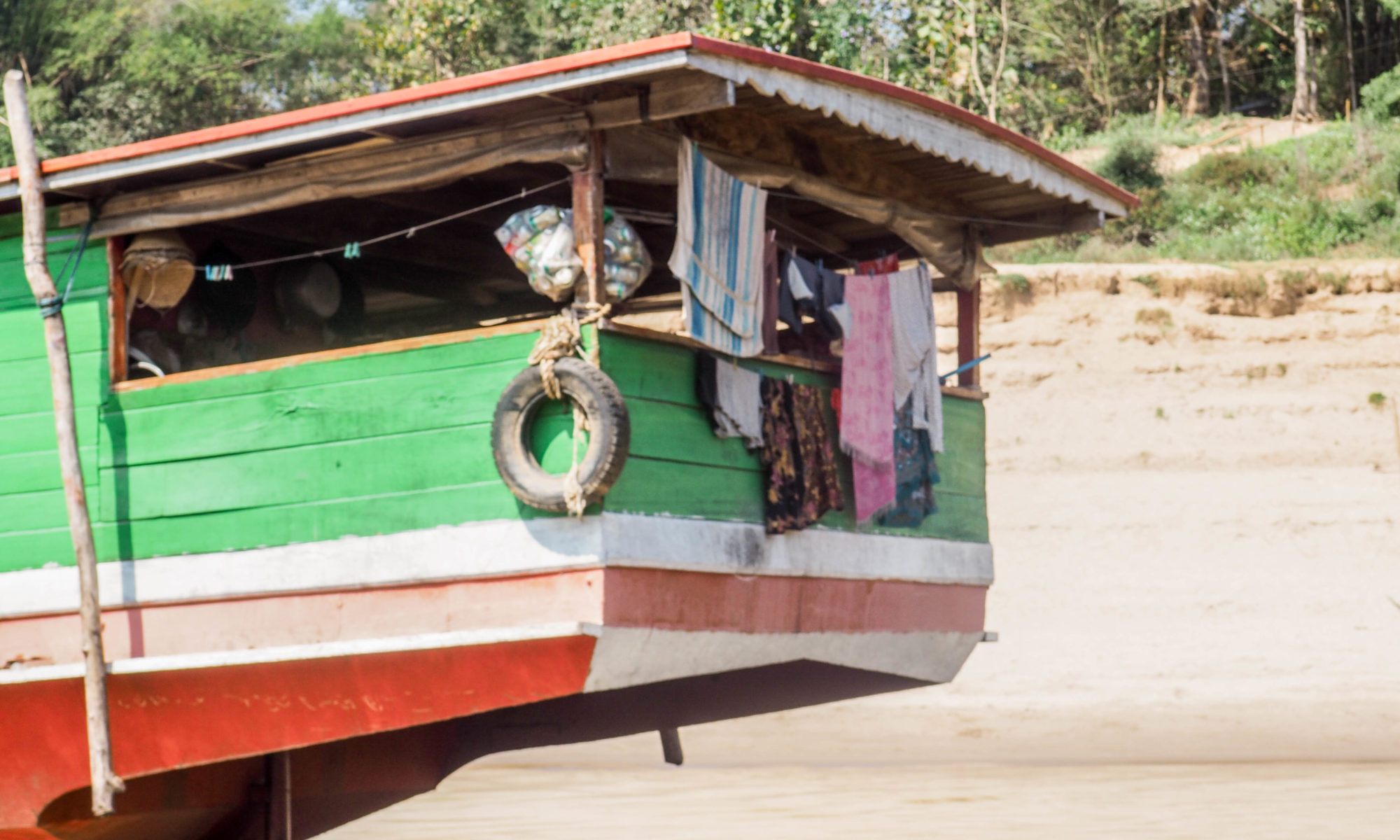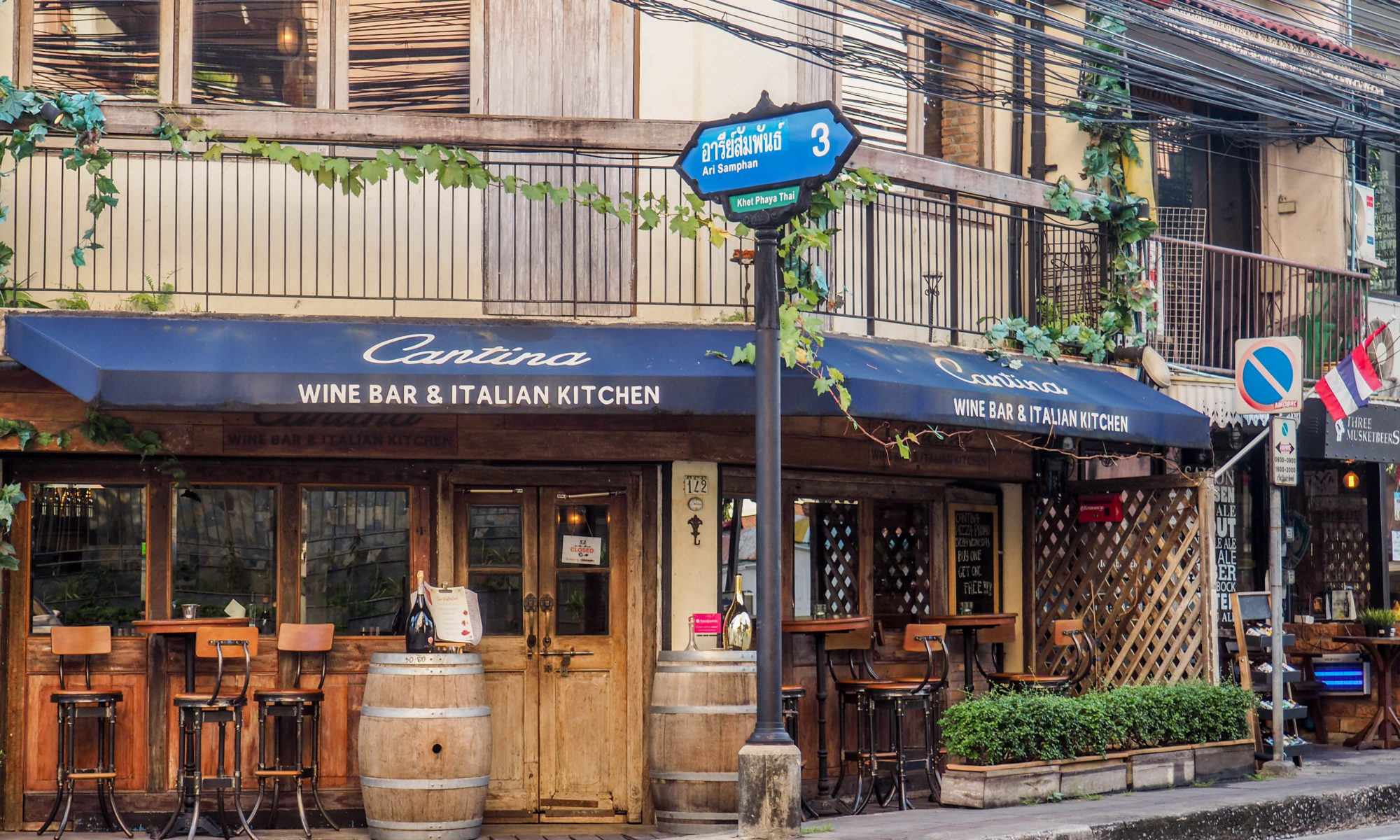Go big or go home certainly applies to diving near Coiba Island in Panama. Whether it’s the sharks in the water, the huge schools of fish or the vultures that loom in the skies ahead. Coiba isn’t the easiest diving spot in the world with its low temperatures, strong currents and rapidly shifting visibility. But the abundance of species, including the elusive whale shark, certainly makes it worth the effort.
Continue reading “Coiba Island, Panama’s premium dive spot”
Visiting the Lost and Found hostel in Panama
The Lost and Found Hostel is one of those places that will never escape my memory. It is set in the middle of the jungle which means monkeys everywhere, gorgeous views from the deck and great free hikes that start and finish right at the doorstep. Add to that great communal meals and a good social vibe and you find yourself in a place you might never want to leave. If you include Panama into your itinerary, you must also include a visit to the Lost and Found.
Continue reading “Visiting the Lost and Found hostel in Panama”
Luang Prabang, Laos
Unesco made a good call by adding Luang Prabang to its world heritage list in 1995. This picturesque town on the Mekong is incredibly beautiful, the prettiest one in Laos. Sticking around here for a couple of days makes sense. The tasty bakeries and night market, great sights and laid-back atmosphere all beg you to stay ‘just one more night’. My advice? Give into temptation and take the time to truly get under Luang Prabang’s skin. I’ll give you the tips needed to do so.
Visiting an Elephant Sanctuary in Thailand
The debate on whether or not to ride an elephant in Thailand has been going on for the last two decades, but most people these days tend to agree that you shouldn’t. Not only does the small carriage on the animal’s back causes it physical pain. The beatings and ‘training’, which basically comes down to mentally breaking the animal, necessary for elephants to allow strangers to ride them, is extremely traumatic, both physically and emotionally. The most obvious alternative, visiting an elephant sanctuary, is becoming increasingly popular. But are these really that ethical? And which one to choose from the dozens of different centres?
– Elephant riding –
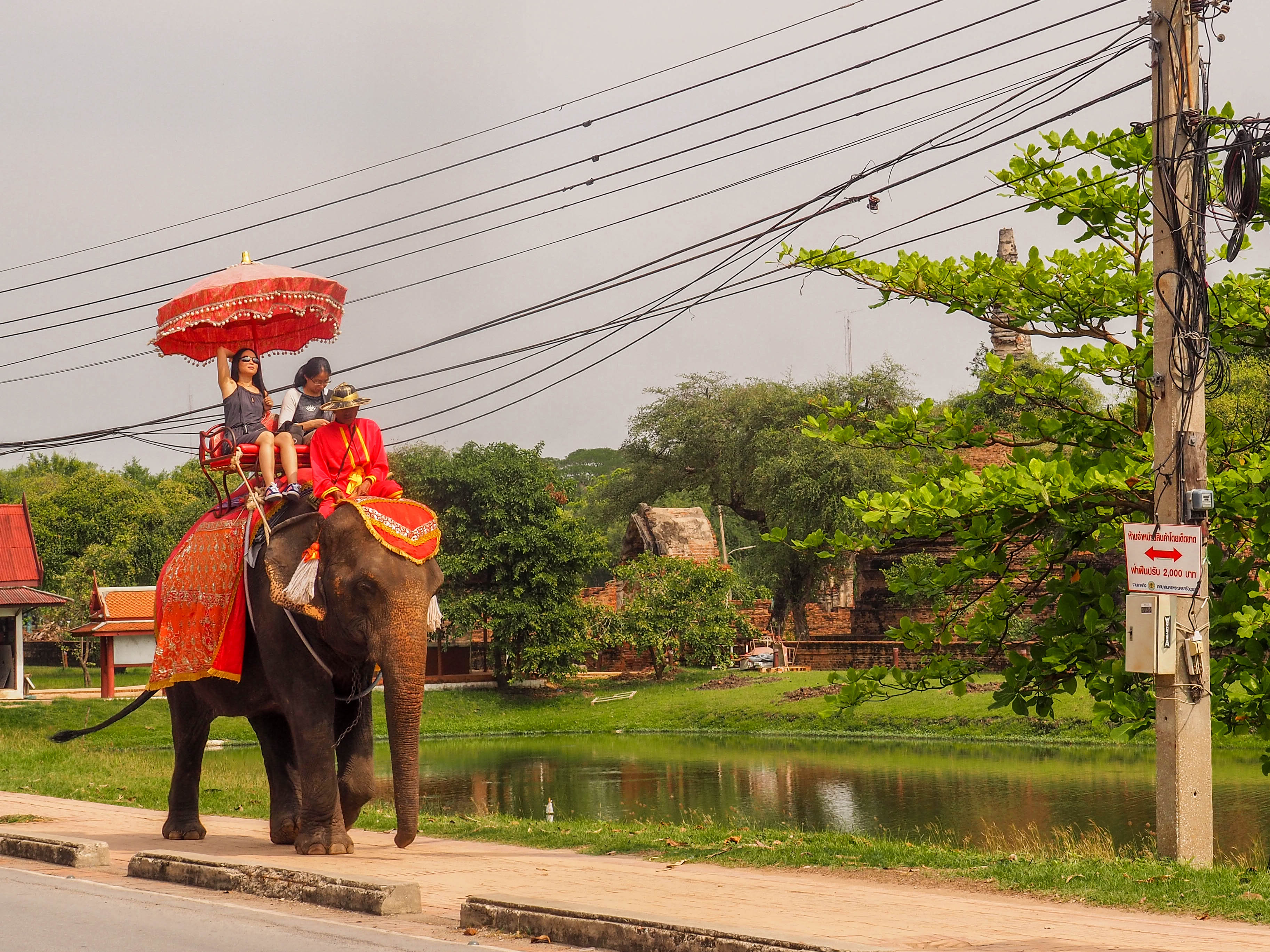
First of all, I feel I cannot write a piece about elephant sanctuaries without first delving into the topic of riding an elephant. Let me start with a confession: I have actually ridden an elephant. I am not proud of it, but that does not make it less true. At that time, back in 2005, I was still a child and I was visiting Thailand for the first time, with my family. We were not aware of the strain it caused the elephants nor the ‘training’ they must endure. The organisation we booked the tour with claimed to work with elephants that were rescued from the logging industry and now could lead a happy life by walking around with tourists on their back. In hindsight, I am not sure whether this was true, but even if it was, that doesn’t make the activity ethical.
Phajaan, breaking an elephant’s spirit
In order to render elephants to submit to their human trainers, they must undergo a process that is called ‘Phajaan’. It basically comes down to breaking the spirit of the animal. The process has been executed for centuries in Thailand and is still used in the logging industry, where elephants are used instead of heavy machinery. Baby elephants get taken away from their family and submitted to months of physical and emotional torture. Eventually, they get ‘saved’ by their Mahout, which is how the special bond between an elephant and its Mahout comes into existence. If you want to learn more about it, One Green Planet did a piece about it, but I warn you: it is heartbreaking and the accompanying videos are graphic.
Working in the logging industry is very traumatic for elephants. They have to work long days under great physical and emotional stress and are often being underfed. While the first tour-companies that offered elephant rides to tourist might actually have offered a better life for the elephants by rescuing them from the logging industry, the sad truth is that the elephant tourist industry got so popular that the process of Phajaan is now also being used to prepare elephants for a life in tourism.
Life in an elephant camp
Even though elephants that are used in the tourist industry are generally treated kindly during the daily hours, this might be a whole different story when the tourists return to their hotels. To control the animals ‘bull-hooks’ are used, a wooden pole with a hook that hooks into a ring in the elephant ears. A similar hook is used in the Phajaan, so just being around someone with a bull-hook already causes the elephant great stress.
The other problem is the riding itself. The elephant spine is not designed to support any type of weight. While a Mahout sitting on its neck might be okay, a small carriage on the top of its back is very painful and can lead to lasting injuries and the crippling of the animal.
Bottomline: don’t ride elephants. Ultimately the decision is up to everyone to make up their own mind, but there is a way better way to interact with these majestic creatures: visiting an elephant sanctuary.
– Elephant sanctuaries –
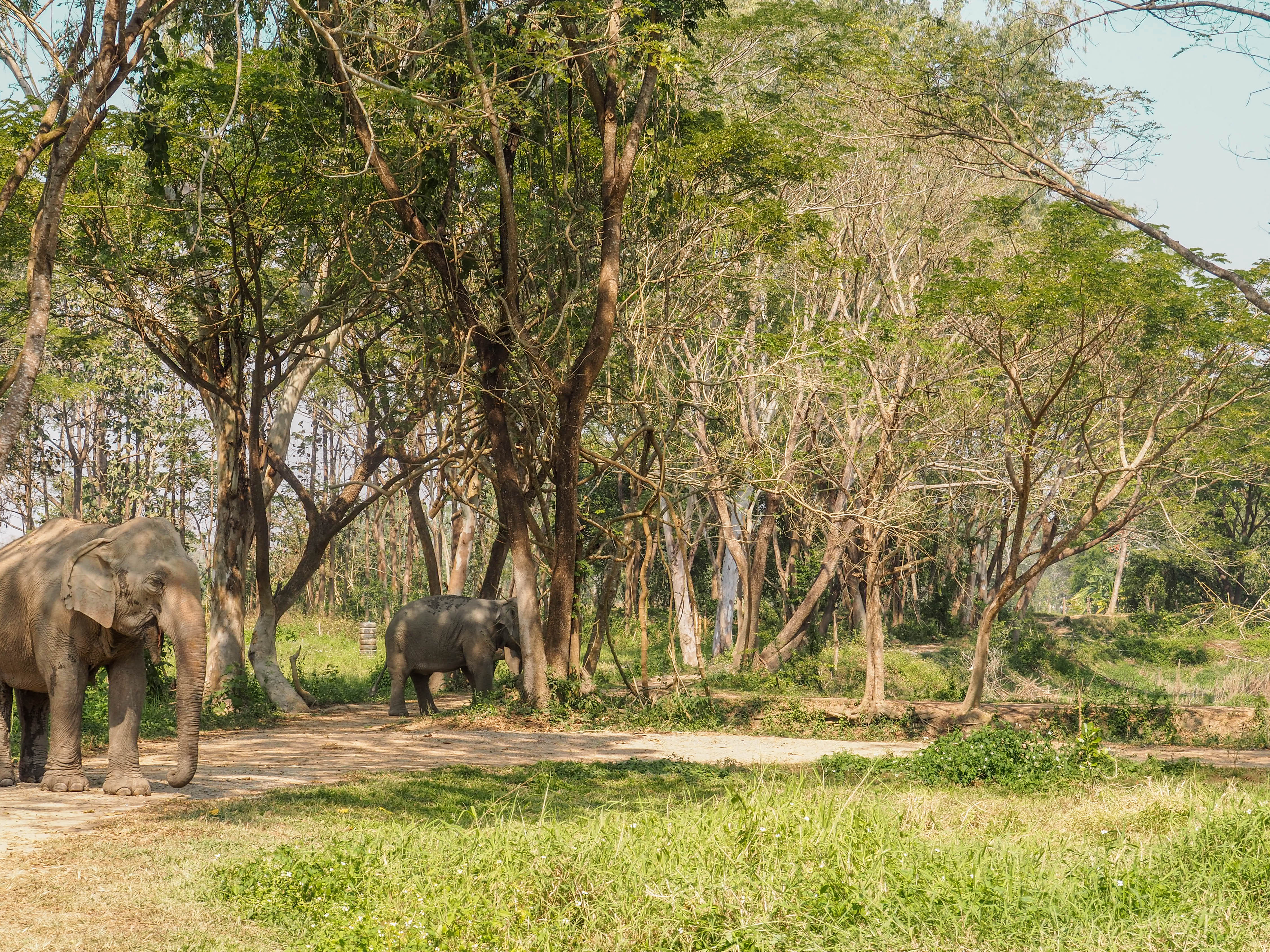
There are a lot of elephant sanctuaries out these so it might be hard to decide which one to visit. The vast majority of sanctuaries can be found in the Northern parts of the country, with Chiang Mai functioning as the ‘elephant sanctuary capital’ of Thailand.
The most well-known ethical elephant sanctuary is probably Elephant Nature Park. They offer day-visits for 2500 baht and longer visits with overnight stays for 5800 baht. It’s not cheap, but consider most money is going to rehabilitation and conservation of the elephants and their natural habitat. Cheaper alternatives can be found all around Chiang Mai. Most hostels and hotels will have some kind of arrangement with a sanctuary or a tour-agency and they all offer similar packages. Expect to pay something in the range of 1500 to 2500 baht.
Consider that cheaper sanctuaries will have to cut costs somewhere. This can (but doesn’t necessarily) mean that the elephants in these sanctuaries receive poorer care.
A day at an elephant sanctuary
A typical day-visit to an elephant sanctuary will start with you being picked up at your accommodation, driving to an elephant sanctuary and getting a tour of the facilities. You will then walk alongside with the elephants, and get to feed them. After the feeding, you’ll get to feed yourself, which is typically a buffet, or multiple-course meal with local Thai dishes. As with everywhere in Thailand, the food is probably delicious. After lunch, you’ll get to walk the elephants to a river or a pond where you can swim along with them or give them a mud-bath. You’ll get dropped off in the city sometime in the end of the afternoon/early evening.
How ethical is visiting an elephant sanctuary really?
Obviously, a day-visit like the one above is mindblowing. You’ll get to see the elephants up close and get to interact with them on a personal level. Feeding, hugging and playing with the animals will be great. It only takes a few minutes up close with these gentle giants to experience first hand how intricate their family-relationships are and how intelligent the animals themselves.
But I cannot help wondering how ethical these visits actually are. Being able to get up close with the elephants, hugging them and swimming with them means that the elephants still have to be submissive enough to humans to eliminate any danger to the visitors. Even though Asianic elephants (contrary to their African cousins) are known for their timid and gentle nature, absolute submissiveness can only be achieved by training them. As long as there are elephants to be rescued this will be no issue as these elephants will already be used to humans. It does, however, beg the question what happens when a baby elephant gets born in the sanctuary. Or when there are no elephants left to be rescued in the logging industry.
Another thing to think about is how natural the elephants’ behaviour really is when it constantly has to deal with humans all around it. Even though it might not be harmful to the creature, it is far from similar to its natural environment.
A different type of sanctuary
It is out of the question that elephant sanctuaries are a good thing. They are. They raise awareness for the mistreatment of the animals and they offer elephants a rescue from an otherwise very harsh life. At this point of time visiting any of them will leave you with an incredible experience, and at the same time will also be beneficial for the Asianic elephants.
But if we look beyond that, there might be an even better way of interacting with these creatures. A way to raise awareness, see the elephants up close and actively contribute to elephant conservation at large. At the moment there are only a few places that offer this kind of experience. Hopefully, there will be many more in the near future. Elephant Valley Thailand is one of them.
– Elephant Valley Thailand –
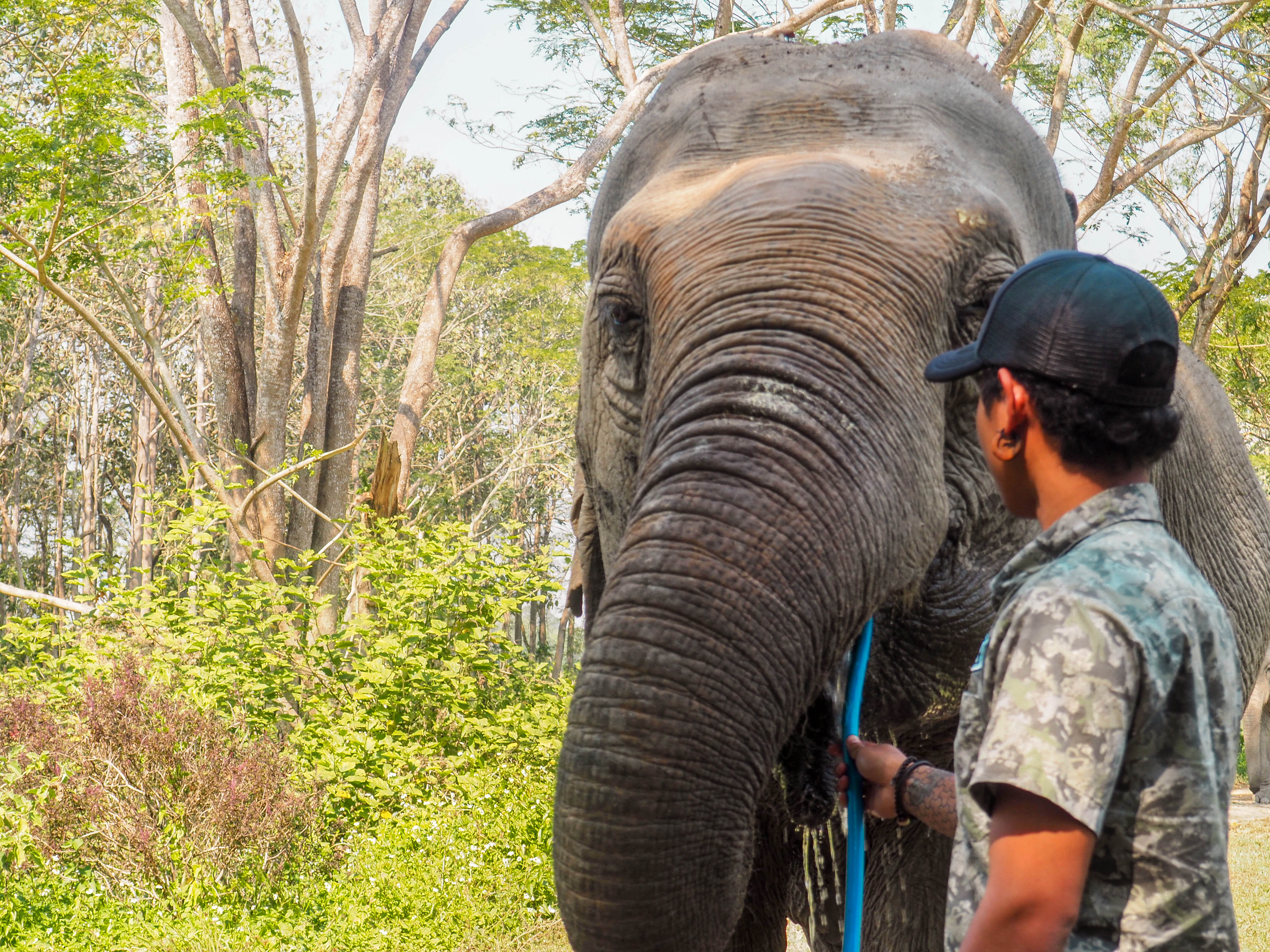
Elephant Valley Thailand is the second elephant sanctuary build by Jack Highwood (the first one is in Cambodia). It is located a couple of miles from the town of Chiang Rai, which is located 2 hours north of Chiang Mai, closer to the Lao border. It differentiates itself from most other sanctuaries by focussing entirely on providing the rescued elephants in its sanctuary the most natural setting possible. This also means that observing elephants here more closely resembles observing elephants in the wild. There is no bathing or swimming with elephants, and the feeding takes place from behind a wooden fence.
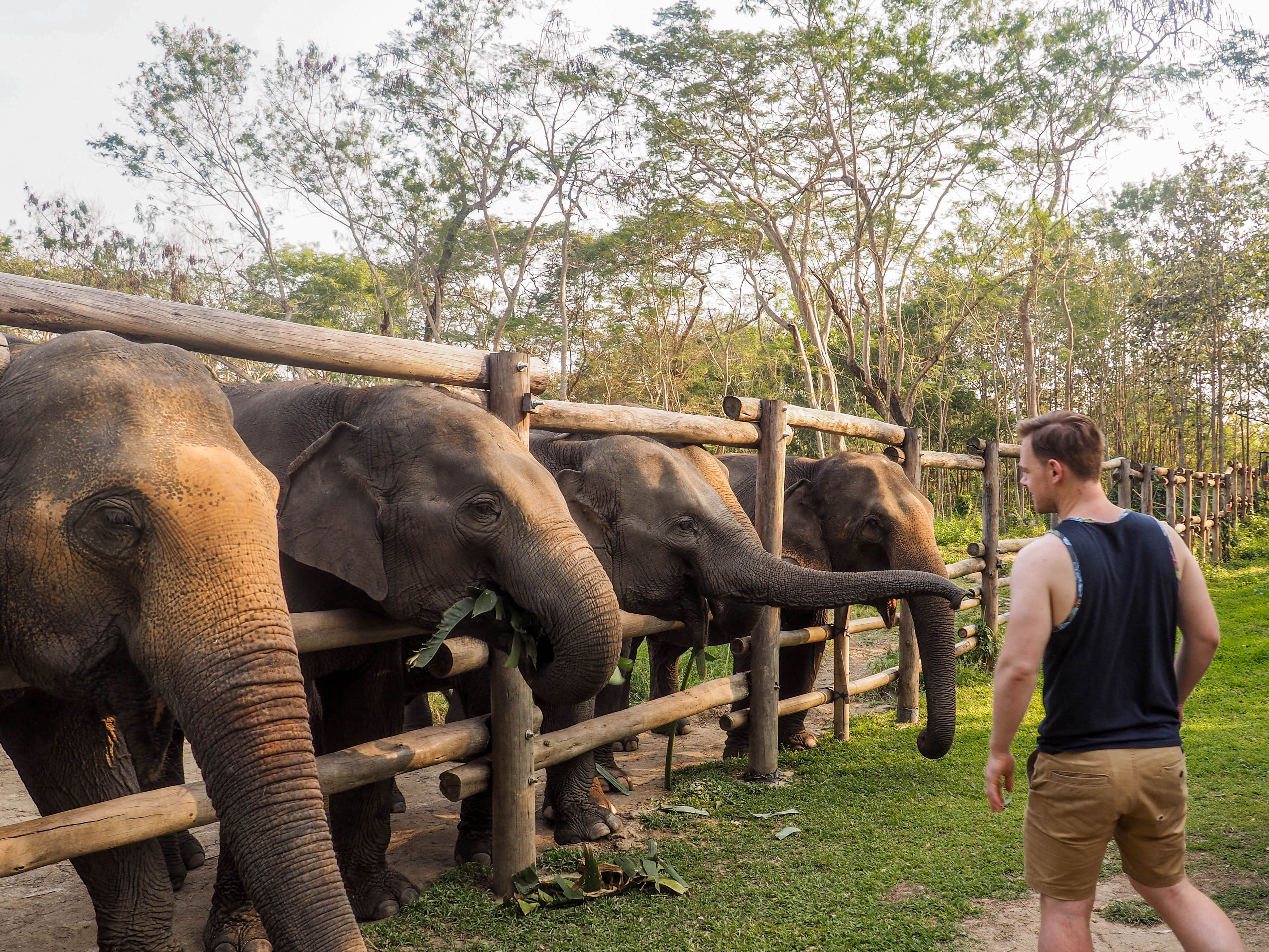
This all allows the elephants to determine themselves how much they want to interact or not. It also means the behaviour of the elephants is not altered by human presence, thus the experience is a whole lot purer and closer to nature. On top of this, this way of running an elephant sanctuary ensures that elephant encounters can also in the future exist without it impacting the elephants involved too much.
A half-day visit
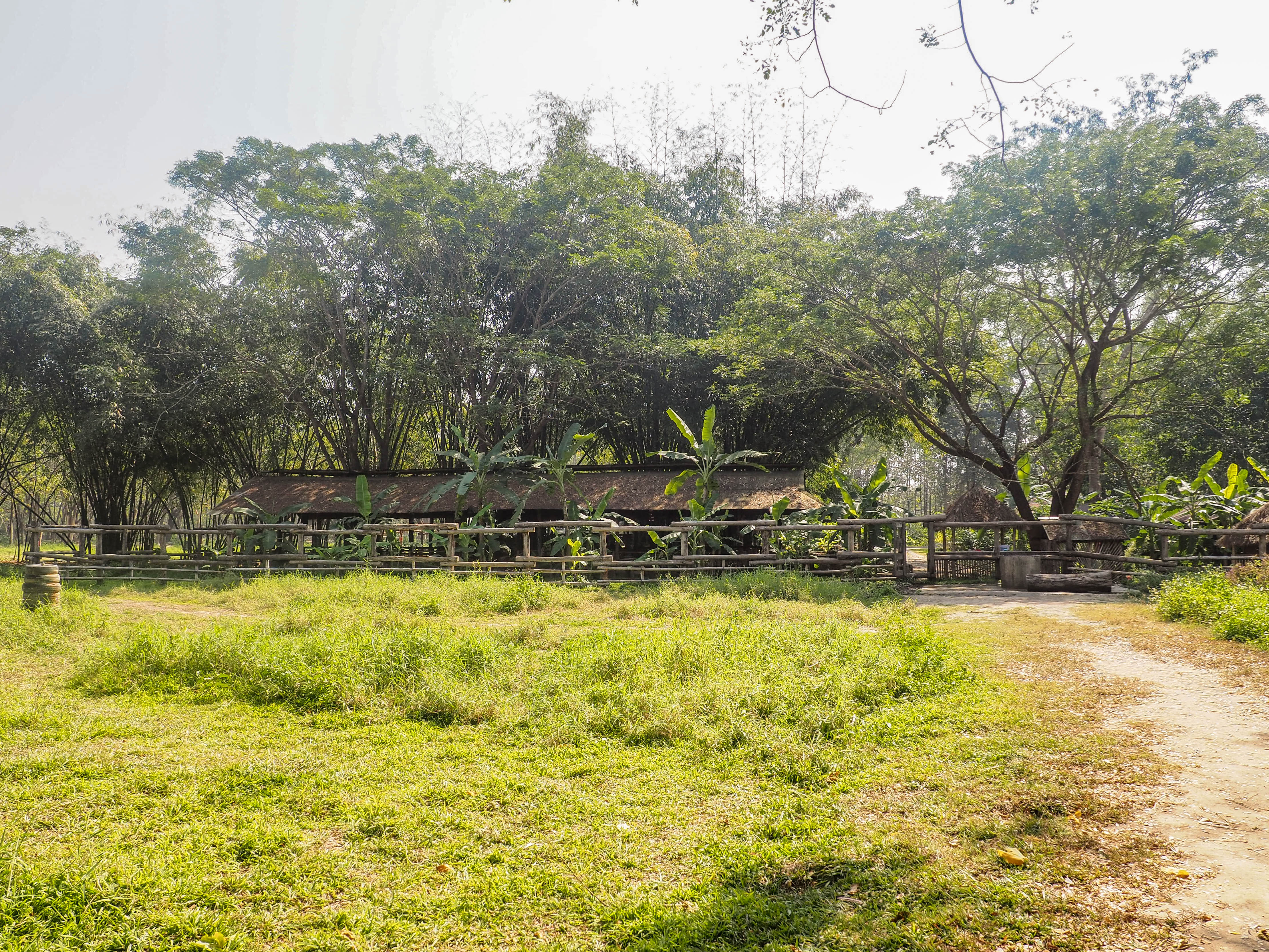
On my visit to Elephant Valley Thailand, I opted for the half-day visit. We got picked up from our hostel in Chiang Rai by taxi a little after 12 PM, that took us there in 10 minutes. The Elephant Valley is located really close to the famous white temple, making it ideal to combine visiting the two. Tip: go independently by bicycle! It’s only about 11 miles (15 kilometres) and they are all flat.
Seconds after arriving at the premises we immediately spotted a few elephants wandering around in the bushes about a hundred meters from us. We got a small tour and got served an incredibly tasty lunch. Good cooking, great flavours. After lunch, it was time to observe the elephants from a smaller distance. One of the volunteers walked with us and opened the gates to the main area where the elephants are. Depending on where the elephants are at you walk around and observe them in their natural habitat. There are a couple of ‘high points’ which you can climb if the elephants get to close.
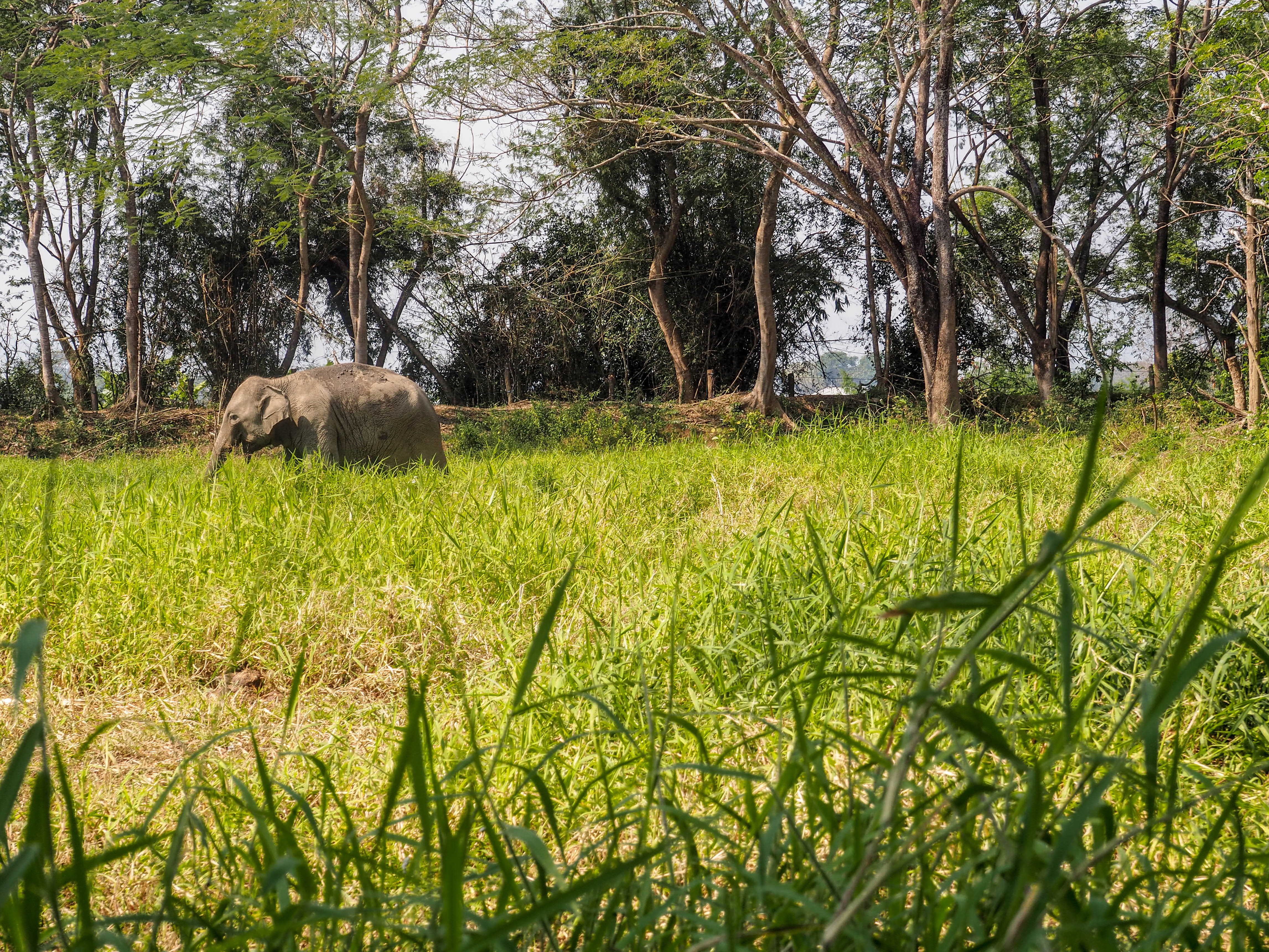
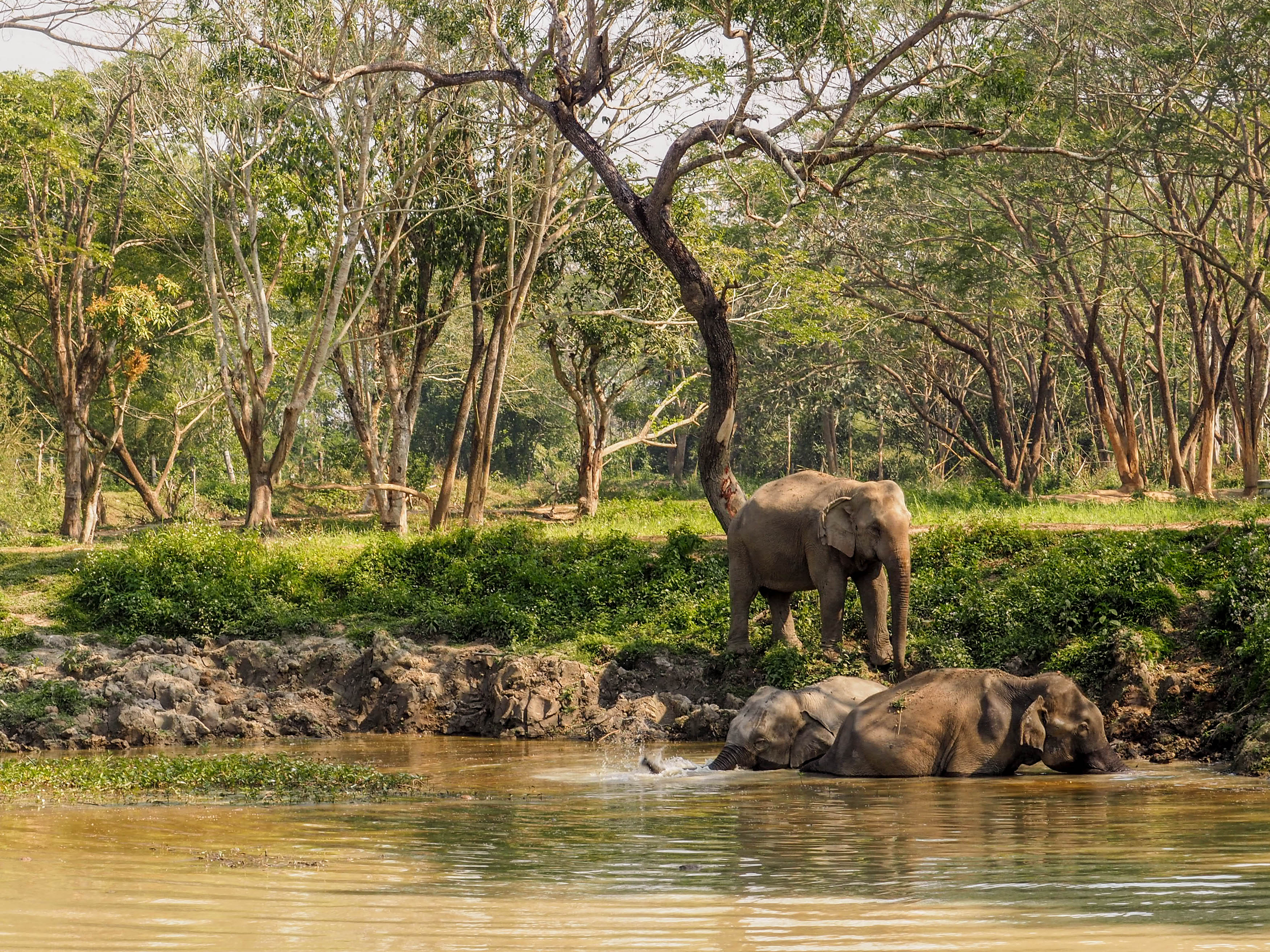
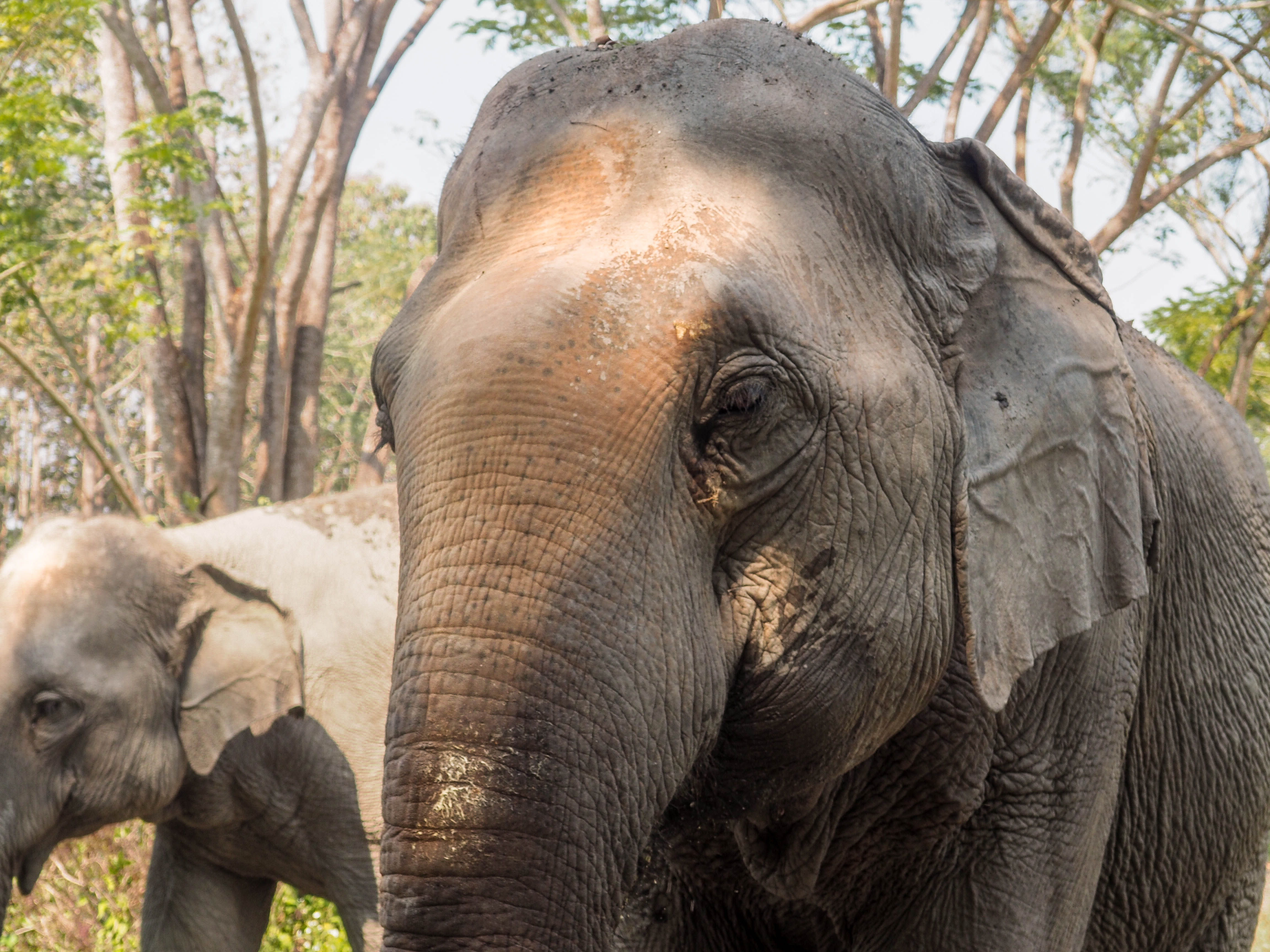
During the walk, the volunteers and rangers explain all about the elephants, and about the conservation programme in general. The whole visit is quite relaxed and you can take as much time as you want on the premises. At around 4 PM the elephants get washed by the Mahouts, which can be observed from a small distance. Afterwards it is time to assist with the feeding. Even though there will be a fence between you and the elephants, this is where you get up close and personal.
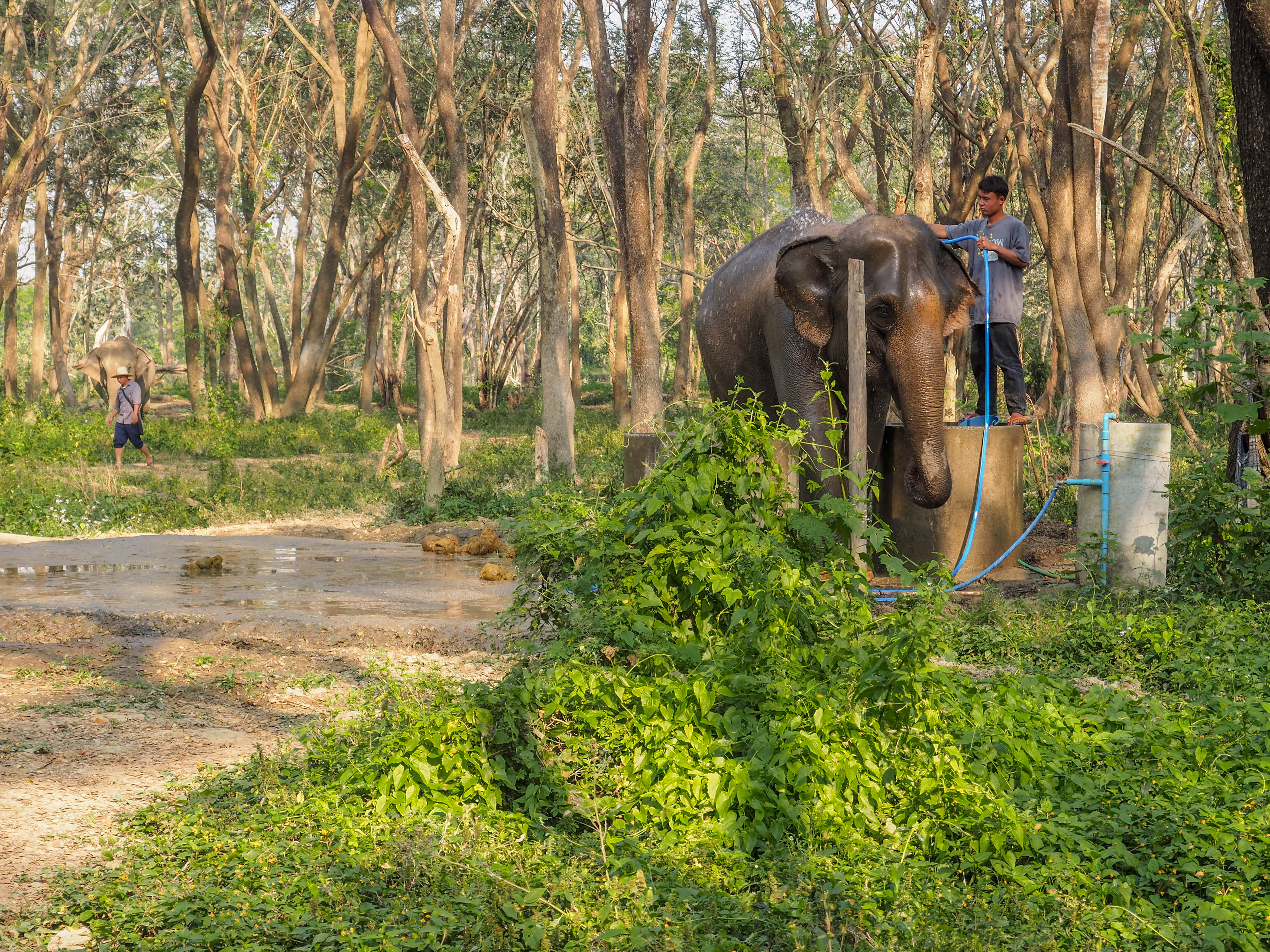
Most days Jack will be on the premises to personally talk about and explain the project. A little before sundown he drove me back to the Chiang Rai where we got dropped off at the night market. A great experience, and probably the most ethical way to get your Thai elephant encounter. It sets you back 1600 baht, of which half goes to wild elephant conservation. The other half goes to maintaining the sanctuary.
Visiting an elephant sanctuary is not something you should skip on a visit to Thailand. I would strongly recommend Elephant Valley Thailand, but whichever you choose, you will not be disappointed.
Vang Vieng, the adventure and party capital of Laos
Vang Vieng is Laos’ adrenaline-mecca. After it’s infamous tubing got heavily restricted in 2012 (too many backpackers drowned or smashed into rocks under the influence of alcohol or drugs) it is desperately trying to re-invent itself as an adventure and outdoor-sports destination. With limited success. Vang Vieng is still largely a party place with lots of bars and raunchy hostels. But with its beautiful surroundings, superb rock-climbing, zip-lining and kayaking options it is setting the table for any adrenaline junkie. So whether you are looking to party, for an adventure, or both, get yourself down to Vang Vieng. It will treat you right.
Continue reading “Vang Vieng, the adventure and party capital of Laos”
What No Road Back is about
You are about to read my first attempt to describe what No Road Back is about. Call it a mission statement or my ‘bloggers purpose’ or just a couple of lines and thoughts of mind on how I view my own travel website. I am in no way trying to convince you that you should radically change your way of travel, but merely showing you mine. At best I hope to inspire, but if I do not bore you to death with this piece I am already sort of satisfied. No, I take that back. Change your ways, get inspired. Nobody is forcing you to read this anyway. You chose this, so you better hang on. After all, there is No Road Back;).
– How I travel –
I am writing have started writing this post at Dubai International Airport. It’s just past 6.00 AM and I am heavily sleep-deprived (still got another 11 hours of travel to go before I reach my final destination). Hungry, but since the coffee I am slowly sipping away already costed me 6 USD, I do not allow myself an overly expensive airport-sandwich. They taste shit anyway, I’ll get my free lunch on my connecting flight in a few hours.
As is usually the case when I go out on a trip, this one started with me racing to the last possible bus I could get, to get to the airport in time. Heaving and panting with my backpack clashing into my back and a smaller daypack dangling on my shoulder I see the bus arriving at the stop at about 200 meters distance. I wave frantically to the bus driver and fortunately, he is in a good mood – made it. My time-management skills might need a tad of improvement.
Make a checklist
Don’t think you will ever ‘nail traveling’. I’ve done my fair share and still forget a lot of the so-called ‘essentials’ everywhere I go. This time it’s my first-aid kid, it is still sitting in Lisan’s backpack from our trip to Morocco last November (she is not joining me on this one). My travel-adapter, my laptop will probably run out of juice in about an hour. Malaria-pills, I really dislike taking pills if it is not absolutely necessary so this one might have been semi on purpose. And my headphones. Not that essential but still stupid to forget. Oh and I changed my bank-card to worldwide settings 2 minutes before the plane took off from Amsterdam – so I can actually pay for something abroad.
Of course, I could have prepared for my trip more in advance. Of course, I could use a checklist. This might have resulted in a more relaxed start of my trip. It might also have caused me not to forget all the things I forgot. And then, it might not have. I also sort of like this free-rolling type of travel. Some things I prepare for in great levels of detail (research on destinations, accommodation, points of interest), others I just free-roll. In the end, as long as you make sure to pack your passport and your credit-card you’re fine. All other things are easily replaceable. Although I strongly advise double-checking whether you got your cell phone with you as well;).
– What the heck is practical sustainable travel? –
So now you know a little more about what kind of traveler I am, it is time to cut to the chase. What am I trying to achieve? No Road Back is about practical sustainable travel: green travel without feeling any hindrance from it. I actively promote this type of travel because I think it is the only way forward. If we like the world so much that we want to explore every nook and cranny of it, we should also take good care of it. And at the moment, the vast majority of the world population is not doing so.
On the other hand, I am realistic enough to know that there is only a very small minority that is actually willing to make (big) sacrifices on their travel-desires in order to shrink their environmental footprint. So that’s where I step in: providing information, guides, articles, tips, tricks and what not, to enable every explorer to shrink their impact without making a compromise.
Practical Sustainable Travel explained in practice
What does that mean in practice? Well for starters, I always put a lot of time into finding accommodation that wants to make a positive impact but without the accommodation revolving around it.
For example, if there are ten clean, beautiful ho(s)tels all with a great social vibe and good reviews I try and find out if any of them also operates in an eco-friendly way. If there is one, great! Most probably I will go check it out and if I liked staying there will recommend going there. If there is one, but it is actually a lot shittier than other comparable ho(s)tels, or more expensive or it f.e. does not provide air conditioning while being in the tropics, I will not recommend it.
That is the practical side of it. If I believe the average traveler will not like the ho(s)tel because its eco-friendly ways make it a less comfortable place to be, its a no go. While there are obviously travelers who would make the sacrifice, those travelers are most probably already making the sustainable choices. I do not believe preaching to the choir to be very effective. This is equally true for travel-agencies, tour-companies and really all companies I work with.
I also will not try to push these sustainable thoughts down your throat, as some other green travel-blogs do. I view sustainable travel as a way of travel, not as the goal of the trip itself. My articles are not about environmentally friendly destinations or attractions but about the most awesome sights, destinations and activities out there, the modus operandi is where I differentiate myself.
If nothing else this will build the business case for sustainability, but hopefully, my articles and writings will guide people in choosing the more environmentally conscious businesses over their direct, but less eco-friendly, competitors. Especially those who want to make the right choices but are not bothered to do the research (which is very understandable, its a lot of work and heck, were a taking about making holiday plans – aren’t those supposed to provide relaxation?).
– What about taking flights? –
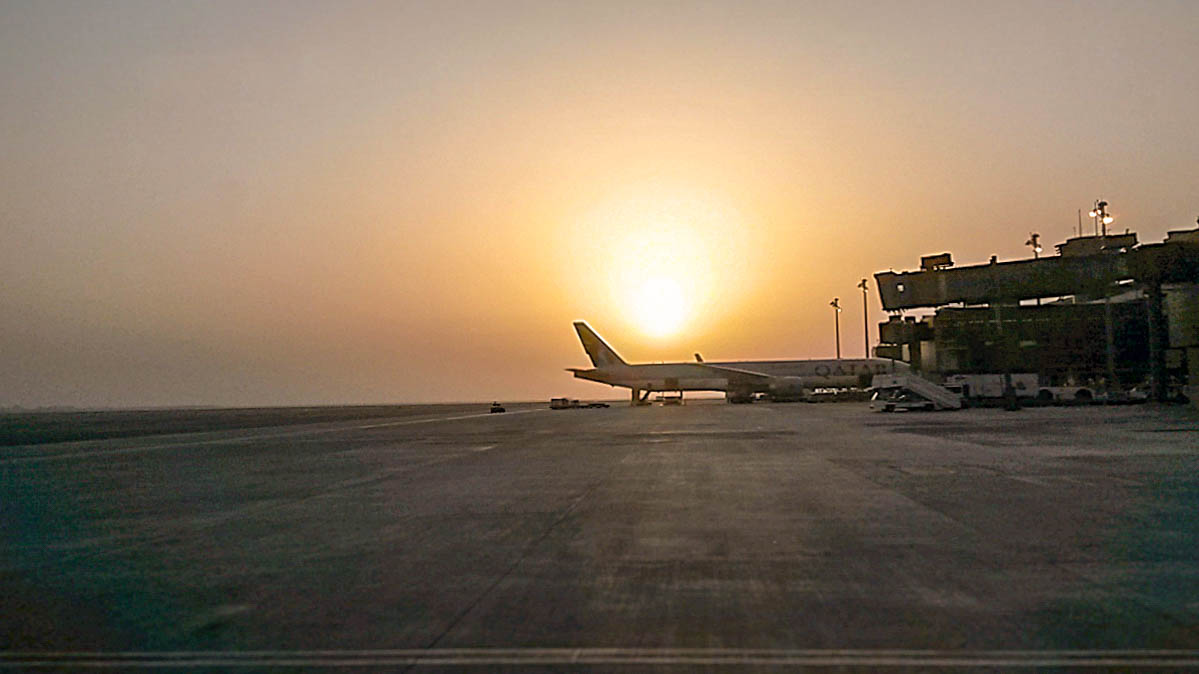
I hear you thinking..”what about all your flights? Isn’t your own carbon footprint huge?” Well, yes and no. Mostly no. I always try to pick local transportation over flying. Not only is it more friendly for the environment, but it is also more adventurous, cheaper, more social and more fun – albeit a bit slow and tiring at times.
Choosing the bicycle
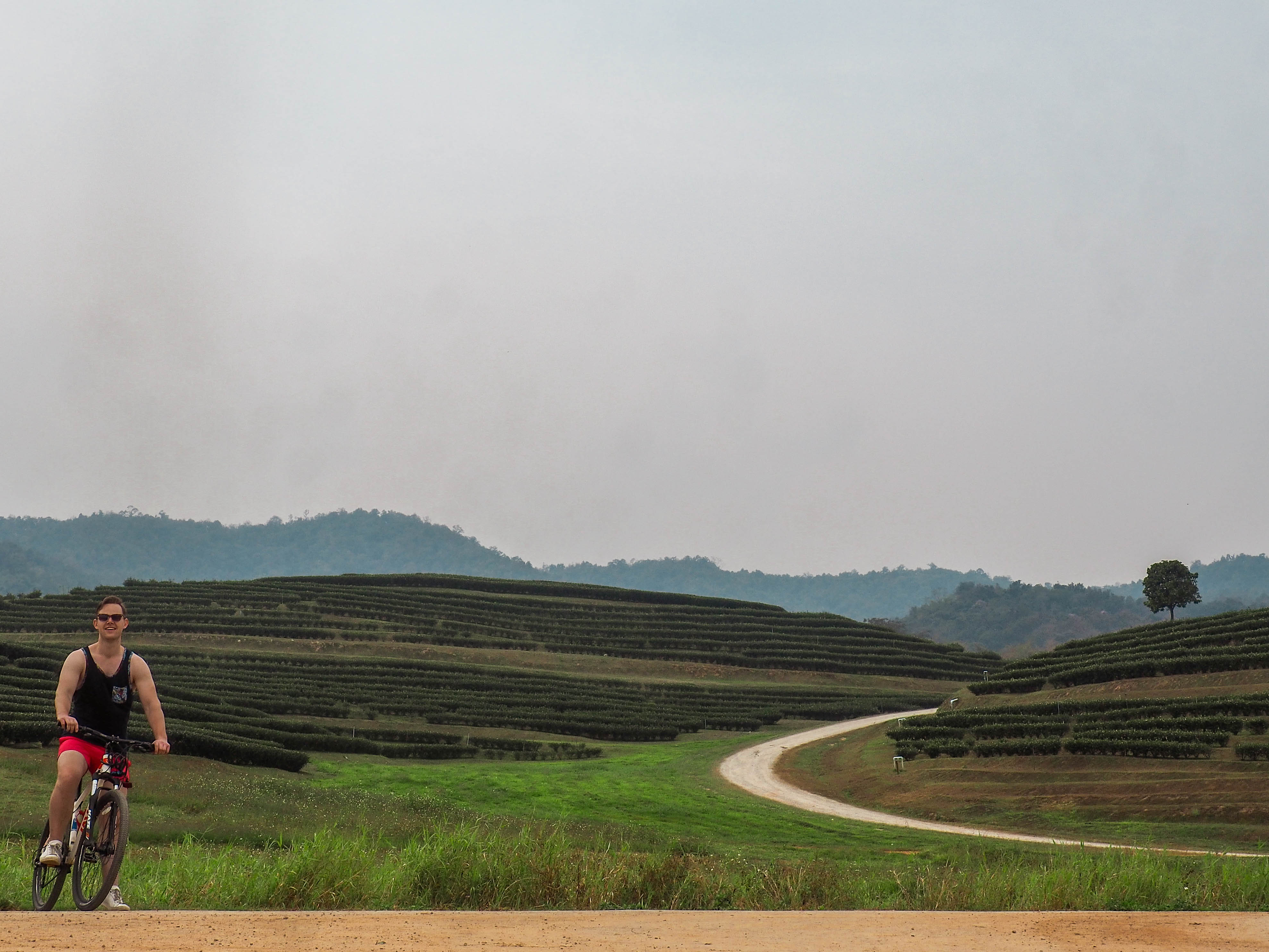
I also try to swap buses and scooters for bicycles wherever I can – especially for independent day trips. Good for your health, wallet, the environment and its way more immersive than the bus or a scooter. So you’ll actually get to feel, smell, hear and in general experience the place you are visiting way more intensely.
Air travel
But indeed going on holiday abroad usually involves a flight and that flight alone is probably responsible for 90% (this is a guesstimate) of the footprint of your whole trip. So how to avoid it? Short answer: you can’t. There are some airlines that do their business more sustainable than others (KLM has been nr .1 on the sustainability index for the last 10 years or so) but they all still use kerosene. The only feasible option there is, which I always use whenever I fly, is compensating it. Click the link below to find out how.
– Epilogue –
That’s right, I am giving this read a proper ending. As I am rounding off this article I find myself a month later than when I started it. I lost my sunnies and broke the pair that replaced it (that’s why I never take proper shades when traveling to Asia), just found out I left my leather jacket somewhere on Bangkok International Airport, and I replaced my flip-flops after losing one at a hostel. As I said, don’t ever think you gonna ‘nail traveling’. Or at least I believe I never will. All you can really do is to make a good attempt. So let me help you to do just that!
Vientiane, Laos
Vientiane is, with roughly 700.000 inhabitants one of the smallest capitals in South-East Asia. Although Chinese investments are spurring a lot of development, this sleepy town has yet to awaken from its slumber. With little interesting temples, sights, and nightlife Vientiane might not sound all that appealing. It is because of its close connection to the Thai border and its international airport, that Vientiane is rarely excluded in any Lao itinerary. So what should you do when you find yourself in Vientiane and want to avoid total and utter boredom? I did the research and came up with a plan.
Luang Prabang day trip: cycling to the Kuang Si Waterfalls
Often dubbed as the most beautiful waterfalls in Laos, the Kuang Si waterfalls can’t be missed. You can get there by organized tour, tuk-tuk or scooter bike but since it is only 30 kilometers out of Luang Prabang I – being true to my Dutch origin – decided to cycle. The ride is spectacular, the exercise healthy and it is the cheapest alternative out there. So give me one good reason why you shouldn’t man up and start peddling!
– Practical information –
This itinerary combines a visit to the waterfalls with a visit to a moon bear sanctuary (which is literally 400 meters from the waterfalls) and a visit to the Laos Buffalo Dairy farm. Cycling the 60km round-trip is interesting for both beginners and more advanced cyclists. If you have a shitty stamina and never work out two climbs will probably have you gasping for air, but they are certainly doable! An expert cyclist would probably dub this one as easy/beginner level.
budget
Minimum of 70.000Kip. 50.000Kip for the rental of a decent (front-wheel suspension) mountain bike. Entrance to the falls is 20.000Kip. Bring extra money for food and water on the way, and add another 50.000Kip if you want to visit the Laos Buffalo Dairy farm on the way back (including 2 scoops of delicious homemade organic buffalo milk ice-cream). It is wise to bring another 50.000Kip for a possible tuk-tuk ride back if you really don’t feel like cycling anymore or if your material breaks down.
time
Approx 4.5 hours of cycling roundtrip. It took me a little over 2 hours to get there and 1.5 hours to get back (during the cooler hours of the day). I am in decent shape but cycled together with two travelers that were less fit. Calculate in enough time to relax, walk around, hike and swim at the waterfalls (a couple of hours). All in all, this is a day-trip. If you leave around 10 AM (as we did) you will get back at around 5.30 PM in Luang Prabang with plenty of time for stops and a couple of hours at the waterfalls. Consider getting up earlier to have a cooler ride. We were very sweaty and sticky when the sun came in at full strength after 11 AM.
what to bring
– Money
– Sunglasses & sunscreen
– closed shoes
– swimming outfit & towel (there are changing rooms at the falls)
– a bottle of water (more can be bought along the way and at the falls)
– sugary snacks to fuel yourself during the ride
– possibly insect-repellant in the rainy season, I didn’t find it necessary in the dry season.
– Preparation –
So apart from the pearls of wisdom that you are probably used to receive from your parents (don’t drink too much, get a decent night of sleep), I would mainly recommend on not departing too late. The day-trip is perfect if you head out early to cycle to the waterfalls in the cooler morning hours and get back a few hours before the sun gets down. Cycling through the heath of the day and cycling back when it’s dark, however – less enjoyable.
Rent a bicycle
Mountain bikes can be rented all around town. I got mine in a little place just across of the public primary school on the northern-side of Phou Si Mountain but in all honesty, there are probably better places around. We went there because we were looking for 3 multi-gear mountain bikes and most places only own 2 decent ones. The best is to just find a rental place close to your accommodation.
Navigation
The route is super easy to find. Use google maps (download an offline map of the area) or maps.me and start cycling in the right decision. Before you’ve left town you will see signs pointing you in the right direction. From that moment on its pretty straightforward.
– The ride –
The way up
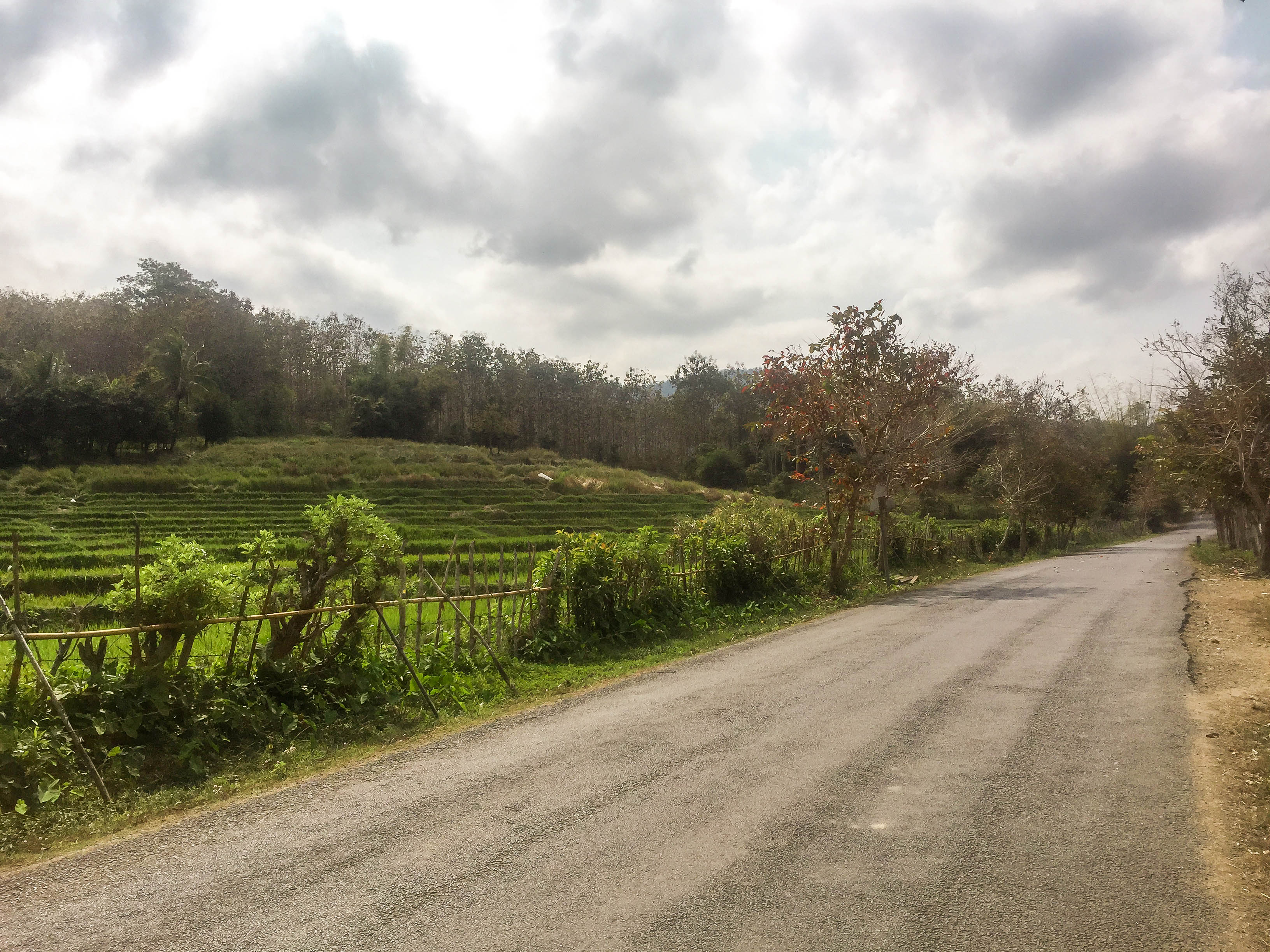
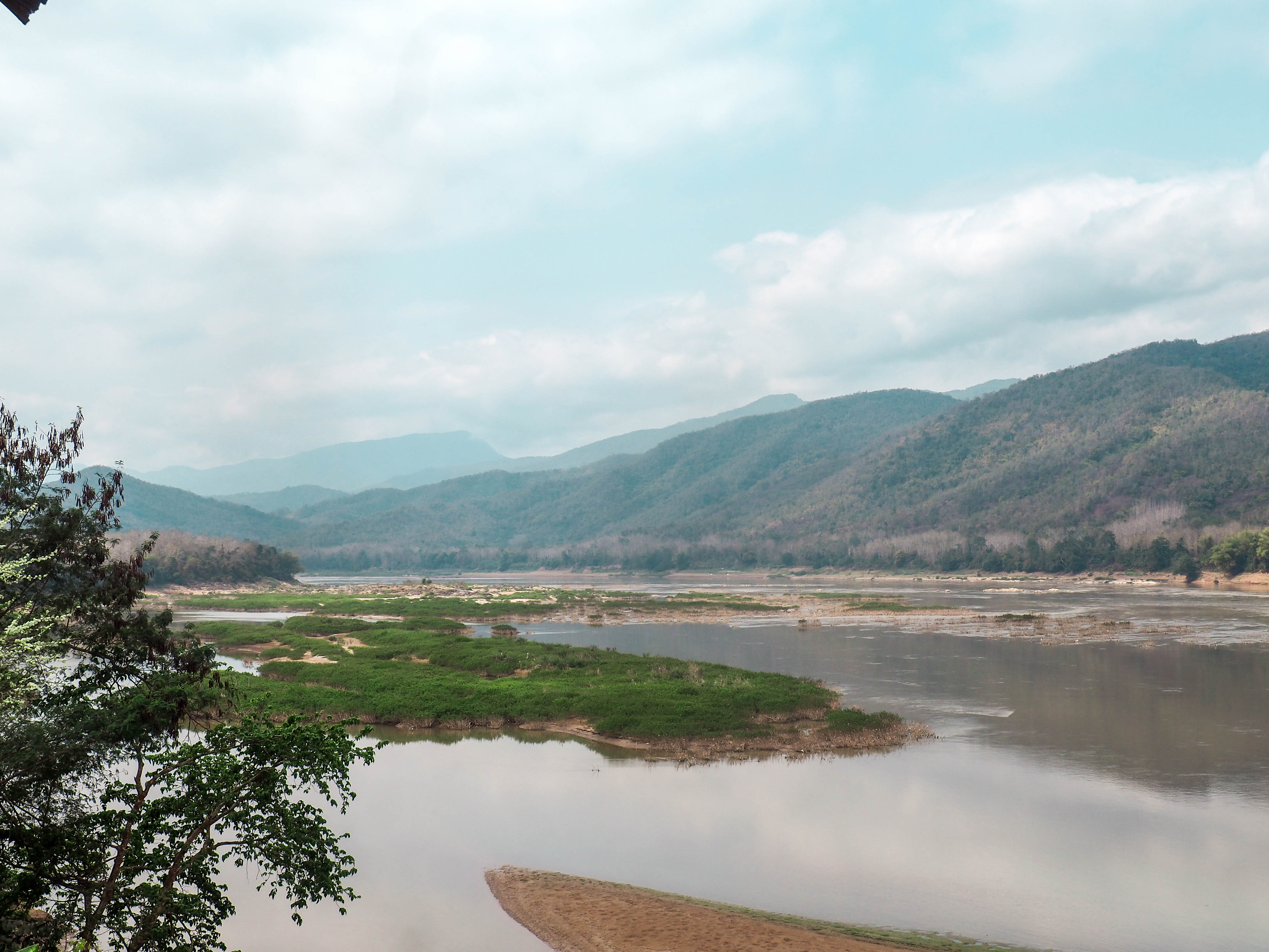
The cycle starts with a few kilometers of reasonably flat terrain. The roads are paved but filled with potholes, enough of them for me to advise you to rent a mountain bike instead of a road bike. After about 4 kilometers you’ll start to feel the incline building up and suddenly a big hill dooms up in front of you. Switch your gears and let the sweat flow freely! This is immediately the hardest part of the whole ride. The incline is pretty steep but short – only 2 or 3 kilometers. When we approached the first hill we decided to all take the climb at our own pace. After a few minutes, when your legs start to ache you notice that suddenly the 2 meters in front of you are way more interesting than the beautiful landscape. This part is all about clenching your jaw, focusing on the road and inching up in the lowest gear until you reach the top. One of my travel companions decided a few meters before we reached the top that he wanted to turn around and head back into town. Little did he know that this climb was really all there was to it.
I wish I would have known, so I could have convinced him to continue because once you reach the top the fun begins. The decline is less steep and stretches a bit longer. For a couple of kilometers you fly down the road at high speed while breathtaking landscapes roll out in front of your eyes. What follows is about 10 kilometers of going up and down. The inclines are short enough to use your previously build-up speed at the last decline to get to the top. As the road creeps closer to the Mekong River the landscape changes from lush forest to farmlands and rice-paddies.
After a while, you have to make a turn left (clearly signaled). This is where you have to start preparing for your final climb. A longer but less steep incline follows for about 4 KM’s right up to the base of the waterfalls. You have to park your bike on the right at a ‘secured’ parking lot. There are lots of shops and restaurants around to have a quick bite before you head up to the waterfalls. You first get to the moon bear sanctuary and then to the actual falls.
The way back

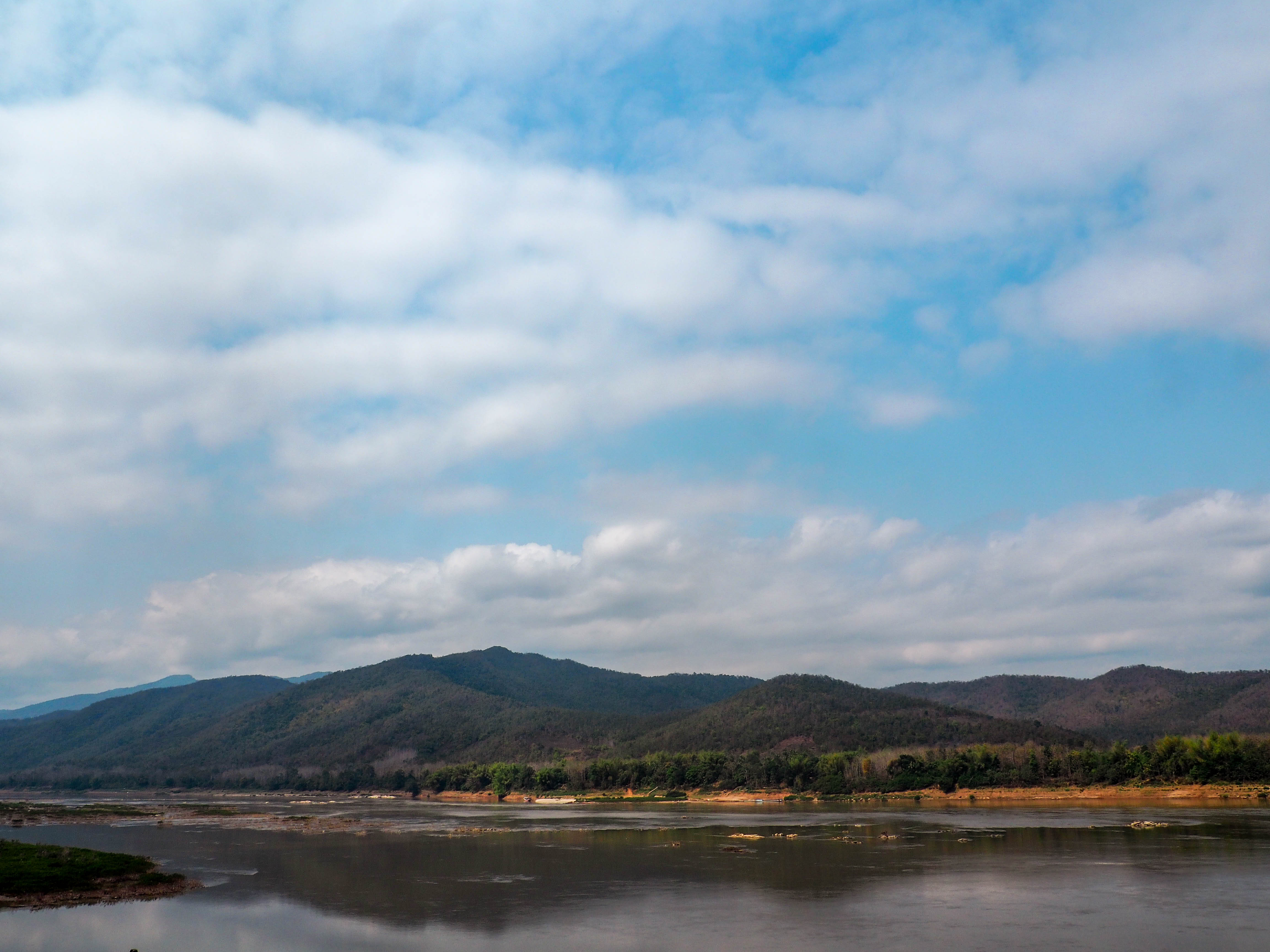

The way back follows the exact same route as the way up (but now with different views – there is No Road Back 😛 – ) but it involves more downhill than uphill and thus requires less effort. You start with the 4 KM decline, turn right and follow the signs to Luang Prabang. After a few kilometers, you’ll see Laos Buffalo Diary farm on your right. A small organic farm where they make dairy and delicious buffalo ice-cream. The buffaloes are well taken care of and this makes for an excellent stop on the way back (the ice-cream included in the entrance tickets is a welcome bonus, and to be honest for me probably the main reason for the visit). There is an option to also participate feeding and take a guided (instead of self-guided) tour for an additional 50.000 Kip but I do not feel this worth the extra 5 bucks.
– The waterfalls –
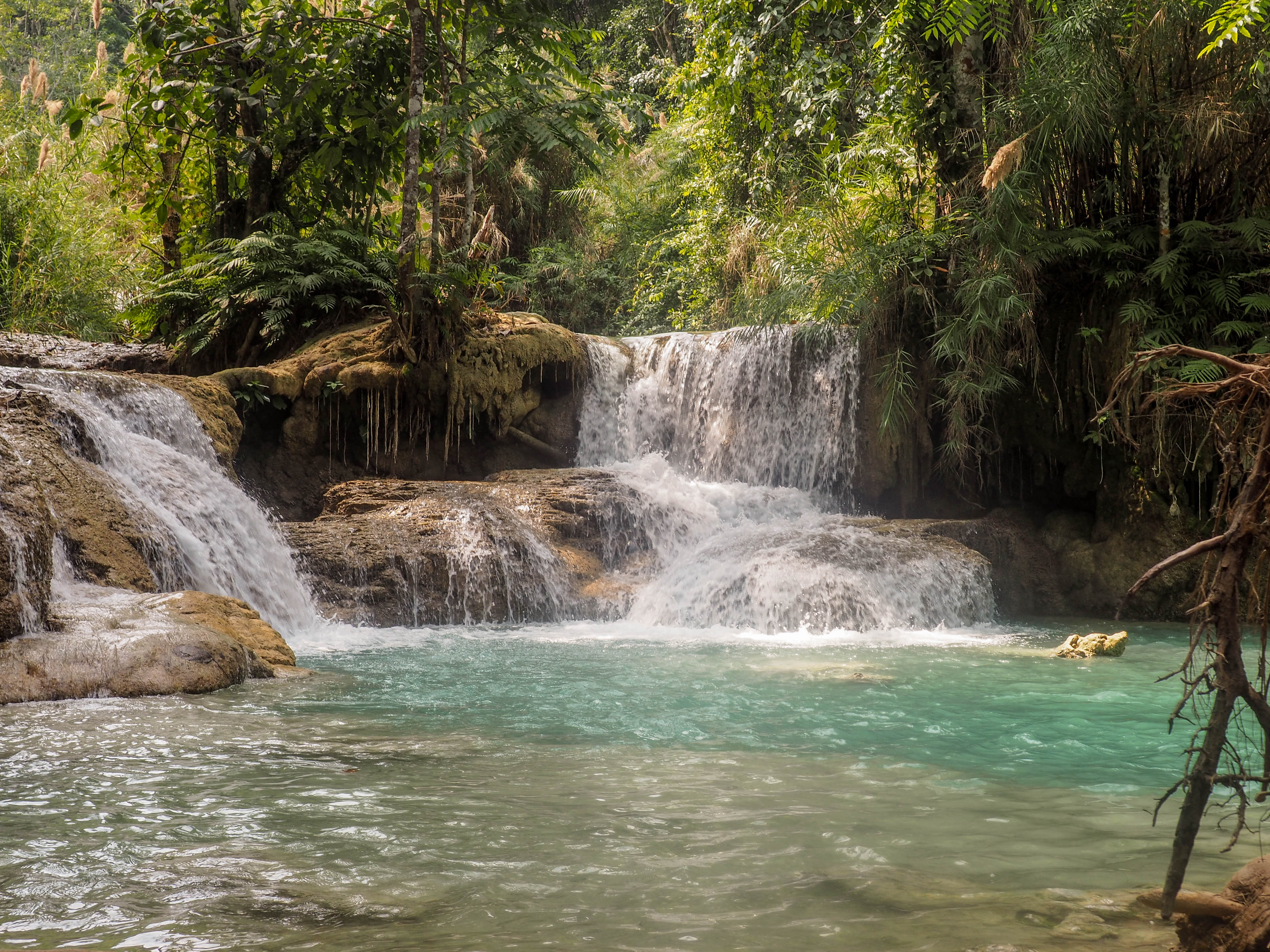
The waterfalls themselves are gorgeous. Even by anticipating on awesome falls, you will not be disappointed. Granted, you do not have all the pools all to yourself but if you manage to find the entrance to the ‘secret pools’ – which are really not that secret – you’ll find yourself almost alone at an incredibly pretty swimming hole.
Moon bear Sanctuary
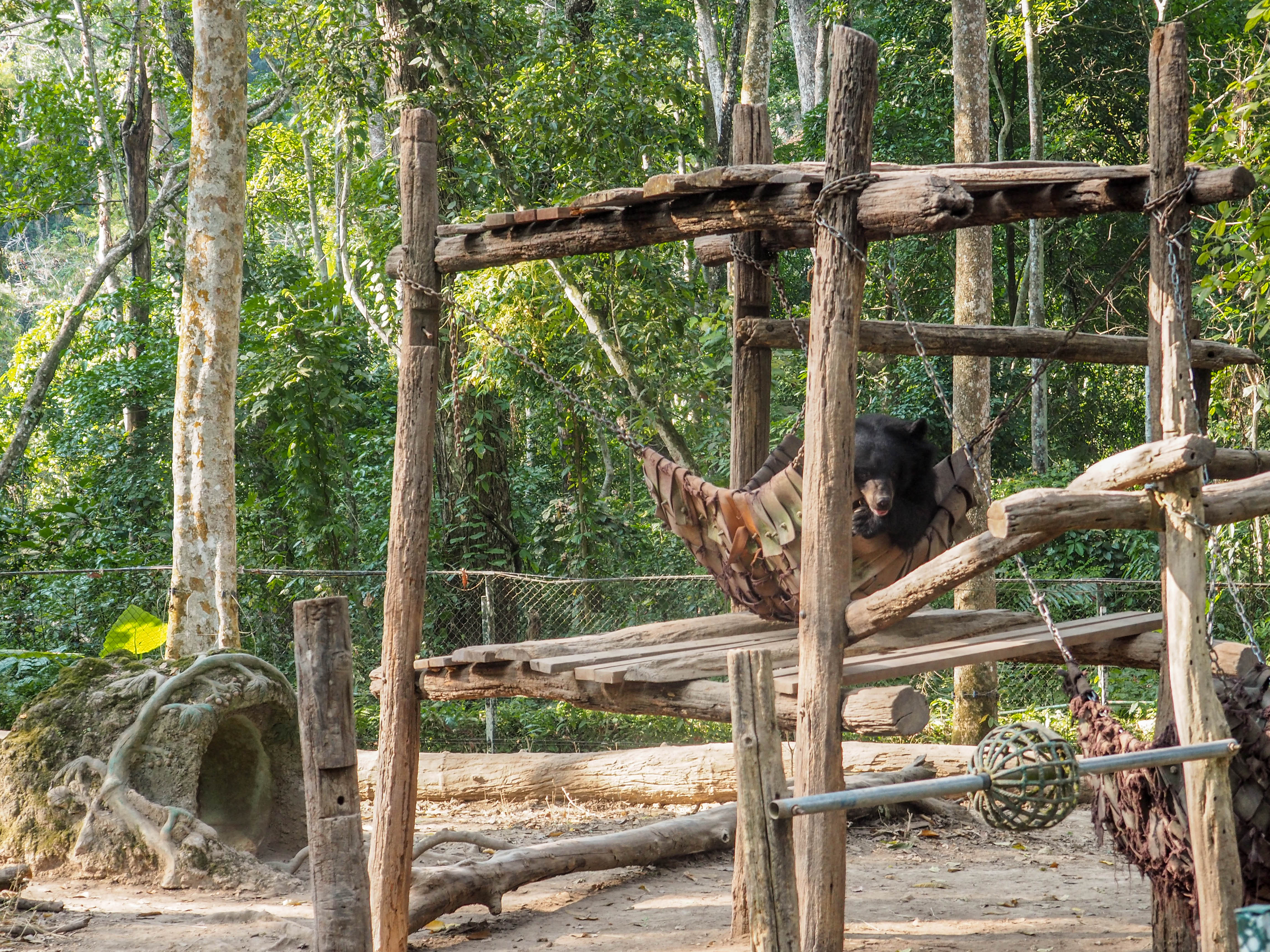
Once you have paid the 20.000 Kip to enter the park you first pass through a moon-bear sanctuary. Here they save moon bear from being killed for their bile to be used in traditional Chinese medicine. I’ve heard many people speak highly of this sanctuary but in all honesty, the bears are still not treated correctly. The cages they are being held in are quite small and the bears all look bored and unhappy. I see no real reason why they didn’t extend the perimeters of their cages except for that it would be harder for visitors to spot them. Obviously, this is a difficult subject since the bears are actually being threatened and the only way to raise public awareness is by actually showing visitors how majestic they are but the visit left a bittersweet taste in my mouth that didn’t wash away easily.
Waterfalls
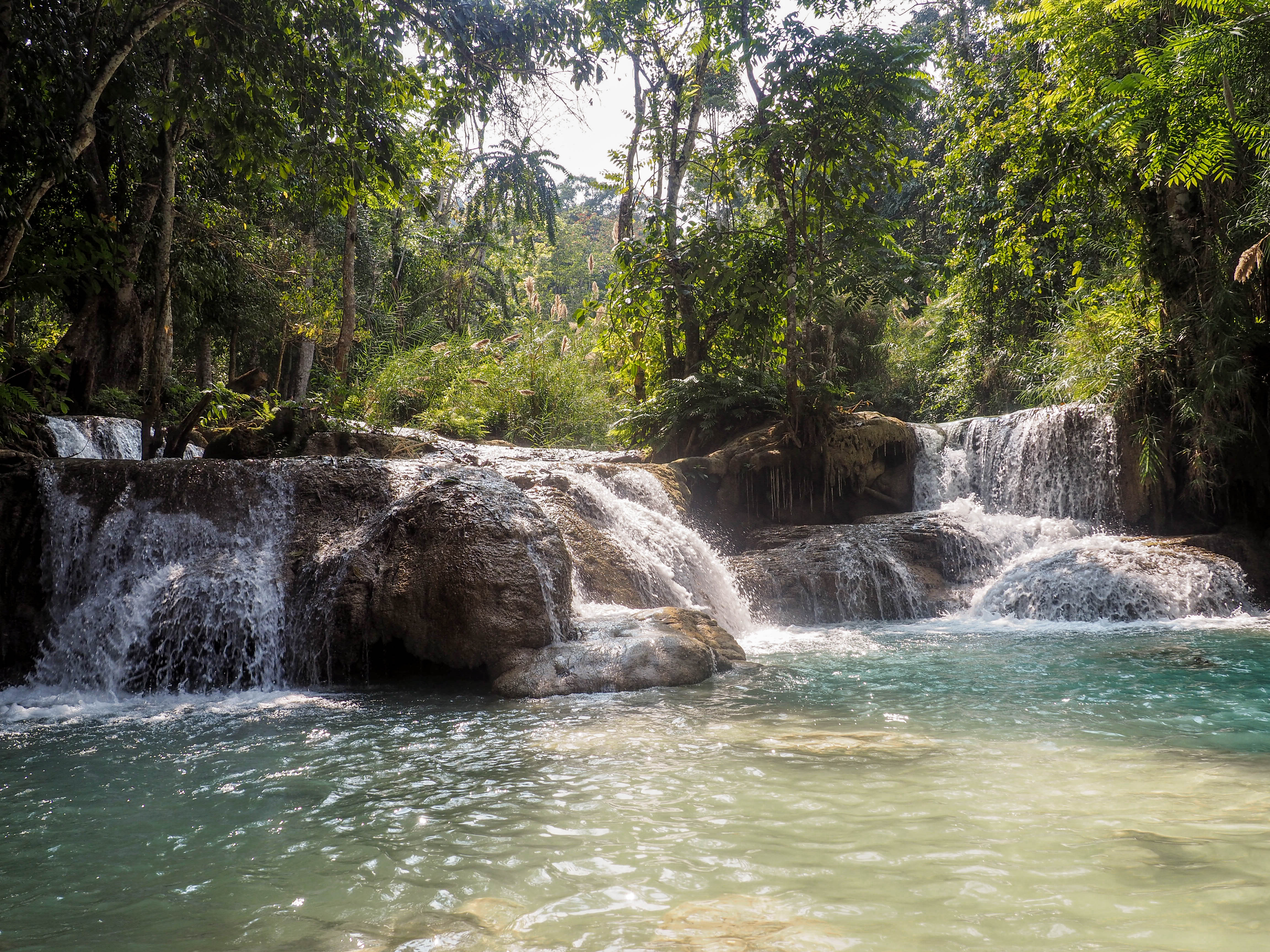
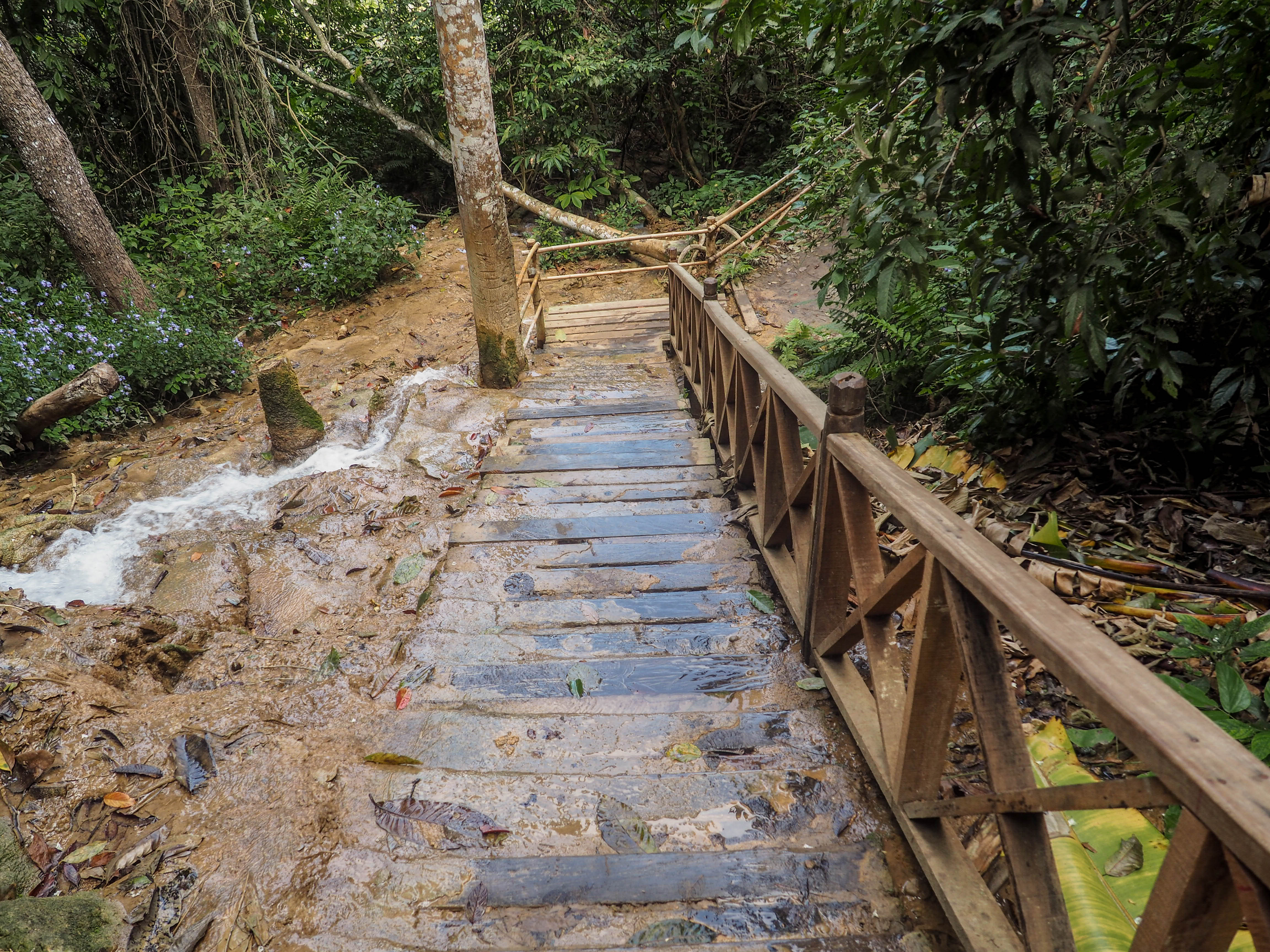
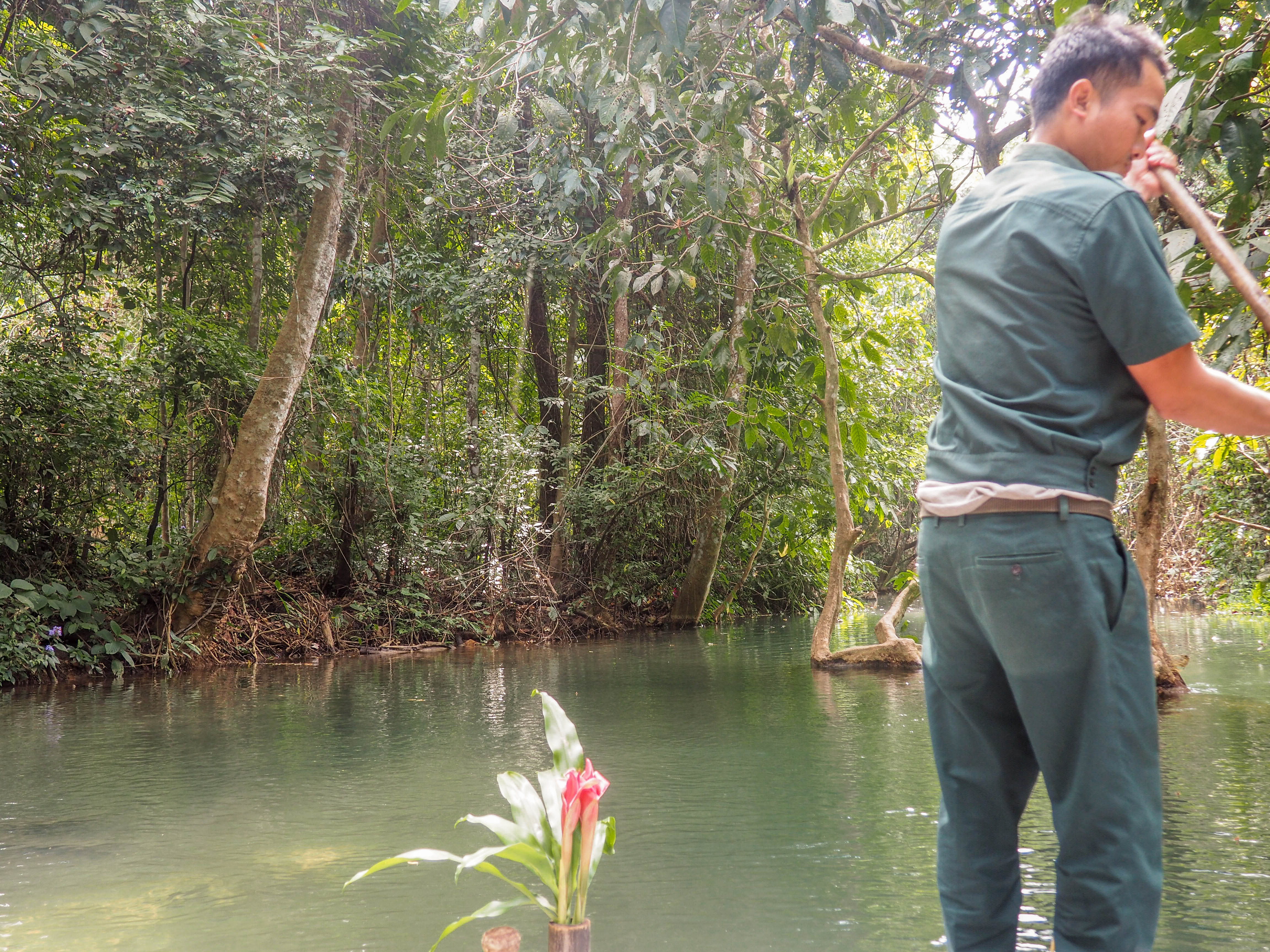
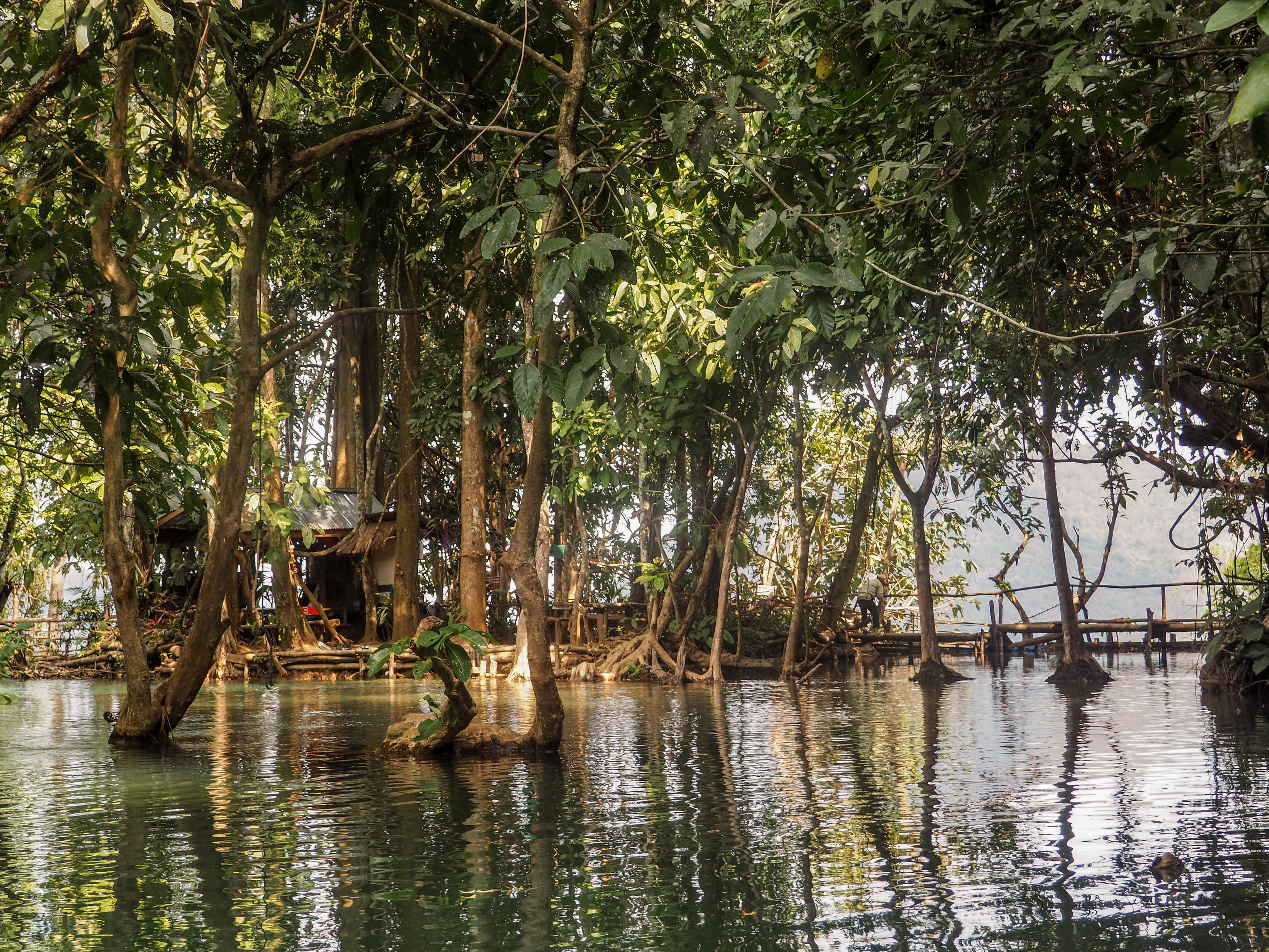
When you walk onward you arrive at the bottom pool of the waterfall where immediately the light blue color invites you to dip in. The lowest 4 pools are all accessible to swim in and even have changing rooms next to it.
You can hike all around the waterfall and go up to the source. Near the source, you can take a small boat to get to the actual source in a bottomless boat (the fish swim right in between your feed) for 10.000 Kip. The boat is a bit of a scam as it only takes you about 30 meters further than the path does. And the source is not a particularly interesting place to be as you can’t really see anything bubbling up. It does, however, provide a different perspective on the place and a relaxed 15-minute boat-ride which for 10.000 Kip might be worth the money spend. Walking all the way around the waterfall takes you about half an hour (with time spend making photos).
The secret pools
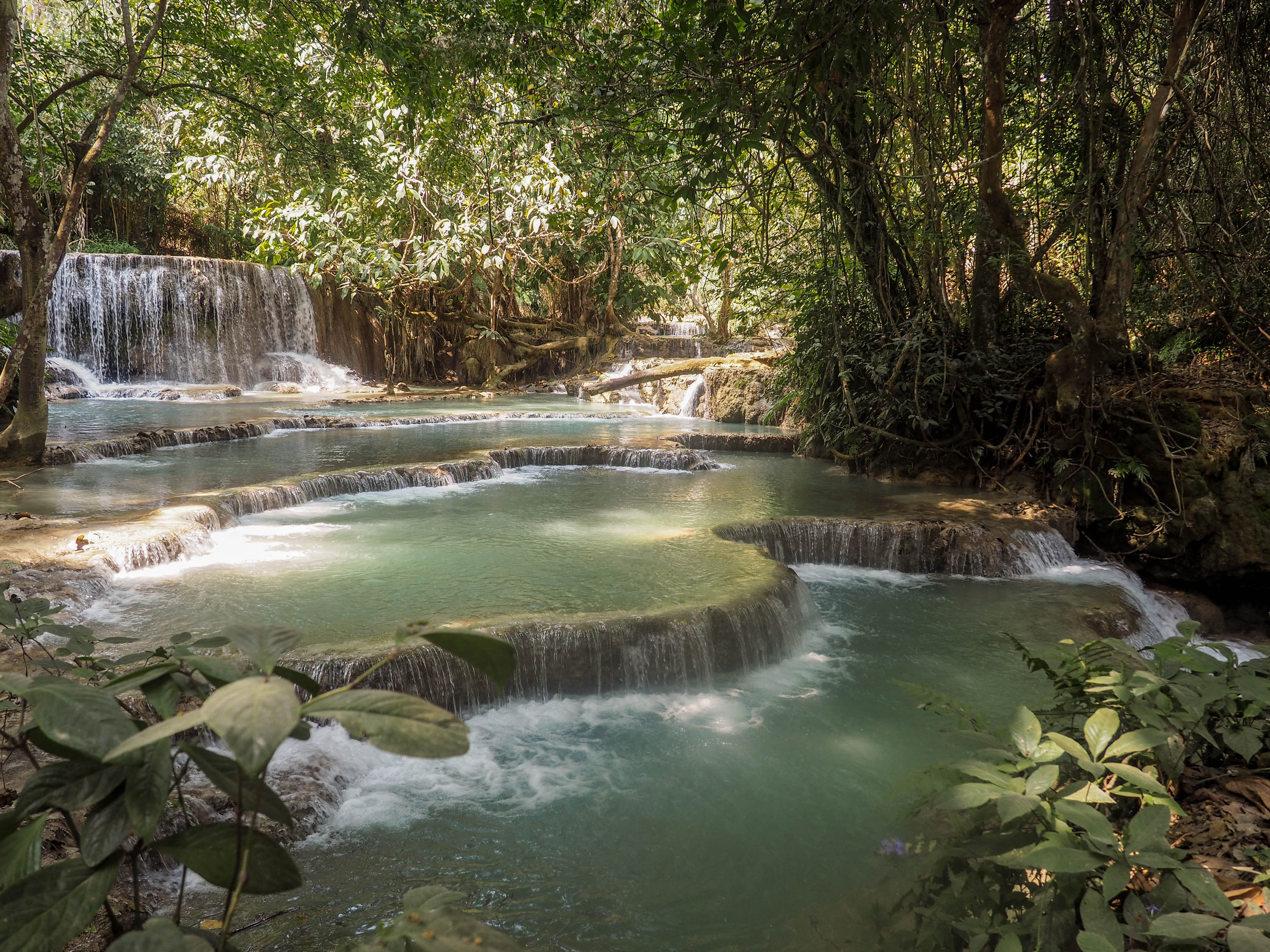
To get to the secret pools you have to head back down a bit until you see a path without a sign next to it heading down from the upper-most accessible pool. Walk for about 5 minutes until you find yourself at a beautiful pool with rocks to jump off from and with deep areas to swim in. But even if you don’t find the secret pools, the Kuang Si waterfalls are gorgeous – so you better not skip it!
Taking the slowboat from Thailand to Laos
Undoubtedly the most adventurous way to travel from Thailand to Laos is by taking the slowboat. For two days you’ll be bobbing around at the mercy of the mighty Mekong river that meanders through the whole of Laos. It’s gonna be chaos, It’s not gonna be uncomfortable and it is definitely not speedy. But the spectacular scenery and social vibes on the vessel make it all the more worthwhile. If you are looking for adventure, there is no better way of crossing the border than by taking the slow boat.
– Practical information –
What to take
In addition to your normal luggage, You need a portrait picture for your Laos-VISA, your Thai departure card and a warm vest/jacket to wear on the morning of the second day. Make sure you have it on you when you get on the boat. I forgot to get mine out of my big backpack (that get’s stored in the hull of the boat) and had to curl up like a little baby on my bench. Shivering under my paper-thin sarong, my fellow travelers who – of course – had not forgotten to put on a jacket happily mocked me and felt snug and comfortable.
Costs
The whole trip costs about 1600 Baht if you book it upfront, a little less if you do it individually. Add 30/35 USD for your VISA + 50-100k kip for a night at a guesthouse in Pak Beng. They are all shitty but hey, the classic Asian ‘shower-right-above-the-toilet bathroom’, is a must-try experience on its own. Bring a couple of dollars/baht extra for random nonsense charges like ‘overtime charge’ or ‘excess luggage charge’ at the border.
You can get the USD needed for your Laos VISA in bigger banks in both Chiang Mai as well as Chiang Rai. Alternatively, you can also just exchange your Thai money at the border (at various points). Take into account a 200-300 baht fee for the exchange (they will not tell you this is a fee but simply give you a shitty exchange-rate).
Duration
Two days, depending on your point of departure. The bus leaving at 6:00 AM in Chiang Rai will have you arriving in Luang Prabang around 4:00 PM.
If you leave from Chiang Mai there are some operators that offer a very early rise, stop-by at the white temple in Chiang Rai and still getting on the slow boat to Luang Prabang on the same day. Most operators divide the trip from Chiang Mai up into 3 days, with your first night spend at the border-town Chiang Khong.
Route
If you depart from Pai you will first take the bus to (the outskirts of) Chiang Mai before you drive on to Chiang Rai. From Chiang Mai also pass to Chiang Rai. The prices below are for crossing the border independently without a package deal.
Chiang Rai – Chiang Khong: 2-3 hours (bus – 70 baht)
Chiang Khong (Thailand) – Huay Yai (Laos): 10 minutes (bus crossing the bridge – 20 baht)
Huay Yai border – slow boat pier: 30 minutes (tuk-tuk – around 50K kip)
Huay Yai pier – Pak Beng: 6 hours (slow boat – 1000 baht at the pier/1300 baht at the border)
Pak Beng – Luang Prabang pier: 7 hours (slow boat)
Luang Prabang pier – Luang Prabang center: 10 minutes (tuk-tuk – 20K kip not included in a package deal)
– Crossing the border –
Think twice before you decide you want to cross the border and take the slow boat independently. It will hardly save you any money, is a lot more hassle and will most probably cost you an extra day. This is because it will be a challenge to be at the pier at 11:45 AM when the daily slow boat departs for Pak Beng. If you are traveling with anything breakable or valuable, either keep it on you in your hand luggage or wrap it well in your big bag. Your backpack is going to be tossed around a lot in the coming days in a not too delicate way.
If you booked a package deal you’ll get picked up at the crack of down from your accommodation in Chiang Rai in a mini-bus. As I only slept for about 5 hours I was looking forward to a bit of a snooze in the bus to the border but alas. Not only was the vehicle packed and were the seats Asian-sized, the chairs lacked headrests which meant no sleeping for me.

You’ll get to the border in about 2-3 hours depending on traffic (I had no delay). Here you get off the bus and go through customs – leaving Thailand. Make sure you got your departure card!. When you’ve passed through customs – there is no real check on anything – you have to take a shuttle to cross the Thai-Lao friendship bridge. Crossing the river means crossing the border. Yay! You are now in Laos! After a short ride, you arrive at the customs where you get your VISA. You have to fill out a form and head over to office nr. 1 where you hand over your form, photo and the dollars for the VISA, which you get back at office nr. 2. With your VISA on hand, you hop on a tuk-tuk to the pier. Make sure your tuk-tuk is actually going to the pier and not the bus terminal. I had to switch tuk-tuks a couple of times since there was some confusion before we left.

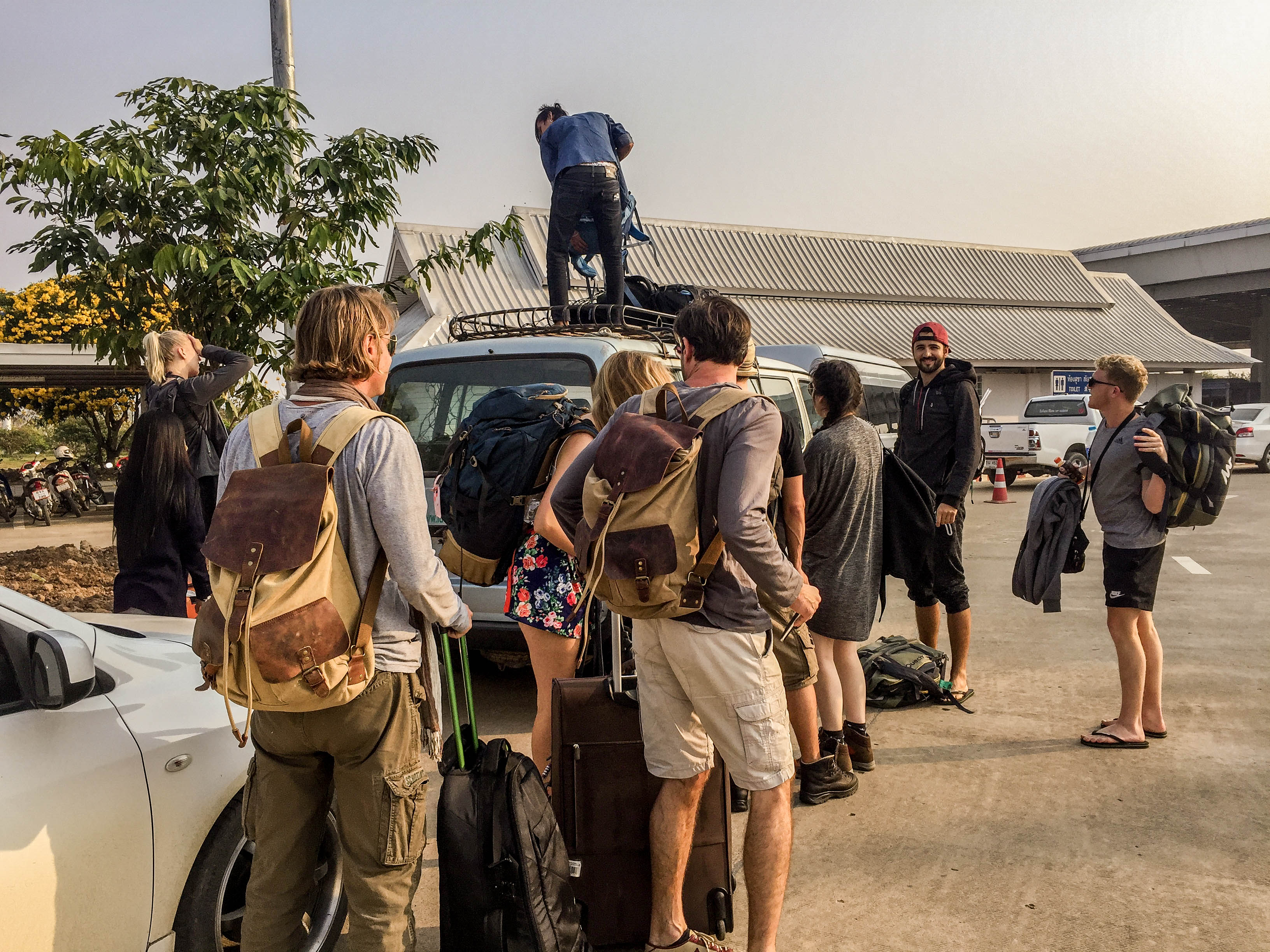




Twenty or maybe thirty minutes later you’ll be dropped off at a shop close to the pier where your ‘tour-guide’ (this would be the first and last moment I actually saw my tour-guide, nor did I knew or was expecting that there would be one in the first place) tells you to stock up on supplies and book accommodation for Pak Beng. He’ll tell you the boat will arrive late in Pak Beng and that you should really book now. Kindly decline both buying food and booking accommodation – you’ll get a way better deal when you arrive in Pak Beng. Food and drinks can be purchased at the pier as well. Beer and snack are available on the boat as well, albeit at inflated prices. Prices at the boat are similar to what they charge you at the office-shop however so I really see no reason why you should stock up there. I – of course – fell into this little scam. I bought a couple of beers and the most disappointing sandwich in Laos and was drinking my luke-warm canned beer for the same price as crisp and cold bottled beer purchased at the boat itself.
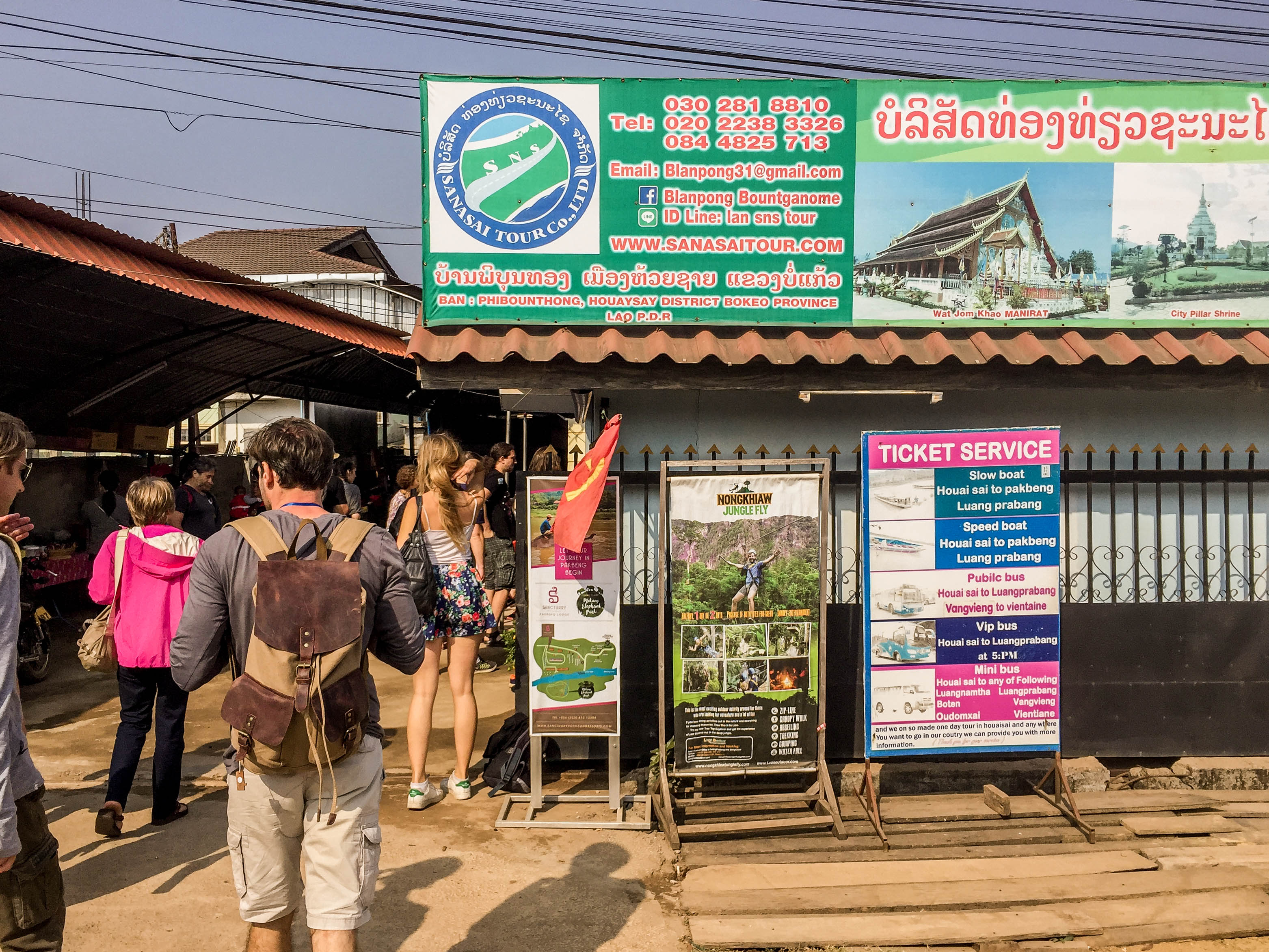
– The slow boat to Luang Prabang –
Day one
When you arrive at the pier you’ll see the boat docked and most probably it is already packed. I hopped on believing I got the last seats – but then there arrived another bus. And another one. and a few more. And some minibusses. And a couple of tuk-tuks. Even though the boat was already packed they kept on loading more and more people on. Chaos started to break out in some families. Sweating parents – crying kids. The expression on the faces of people lined up to get onto an already packed boat – priceless. The expression on the faces of the boat-workers ensured me that this is the norm. So do not stress out and just enjoy the show.
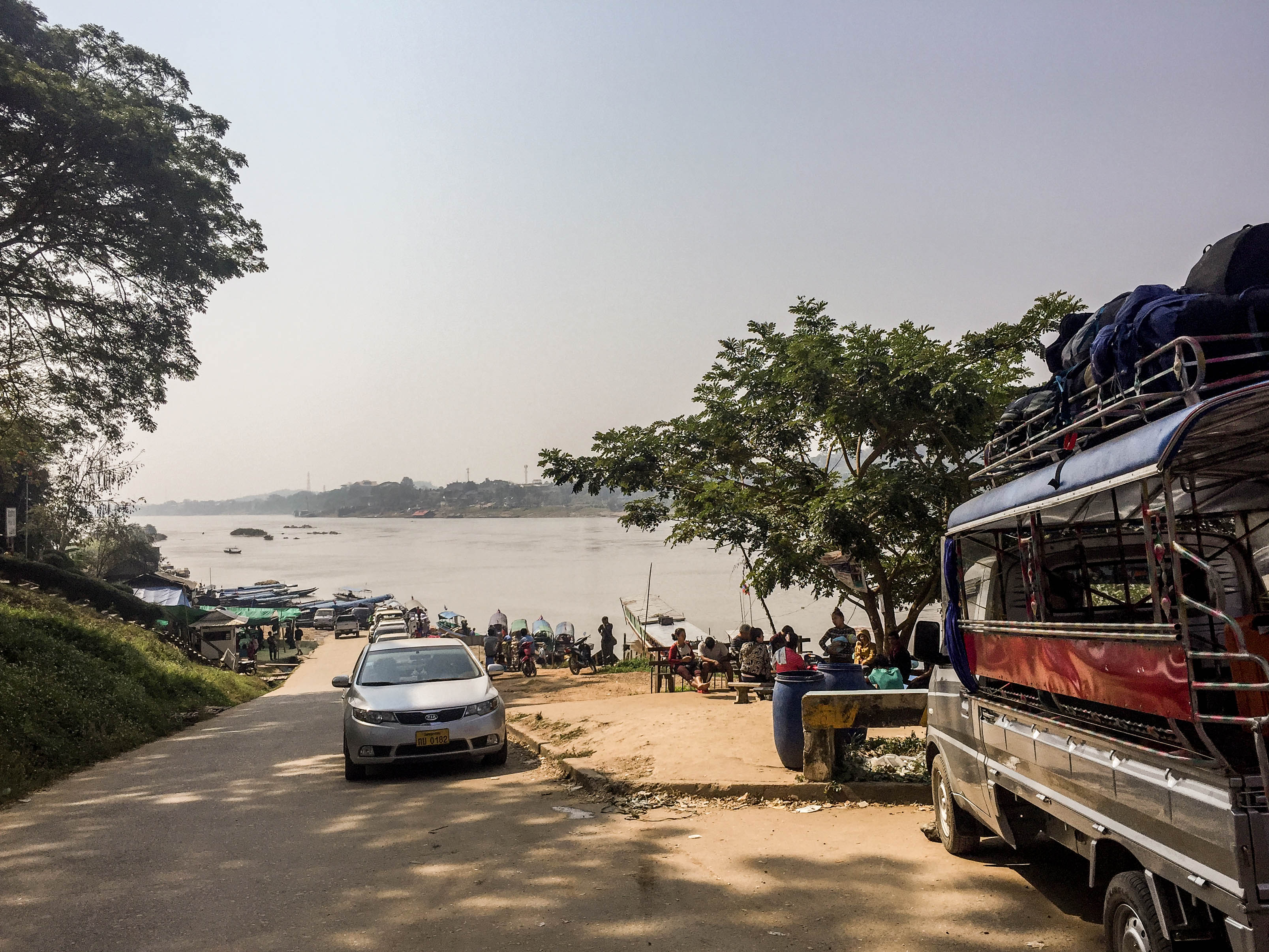

Do make sure you are not one of the last 30-50 people to get on the boat. The last seats are in the engine room and your ride will be dreadful. The sound of the engine will have your head spinning for days and the petrol-fumes will make you feel nauseous – and probably aren’t that healthy either.
When the boat departs instantly the whole ride gets more enjoyable. All seats in the boat are just loose bus-seats that can be turned around to form little get-togethers. People play cards, chat with each other and take in the spectacular scenery.
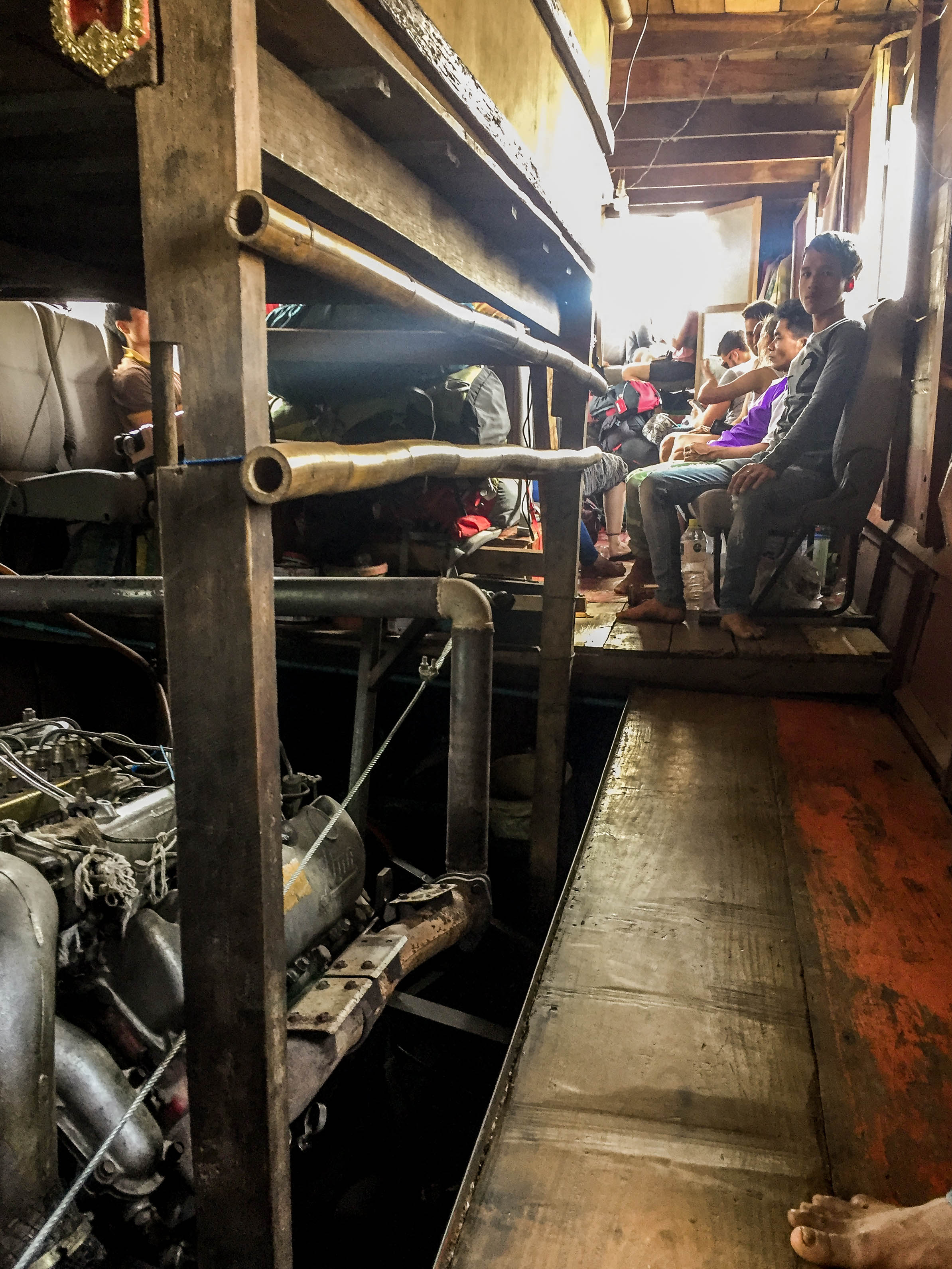
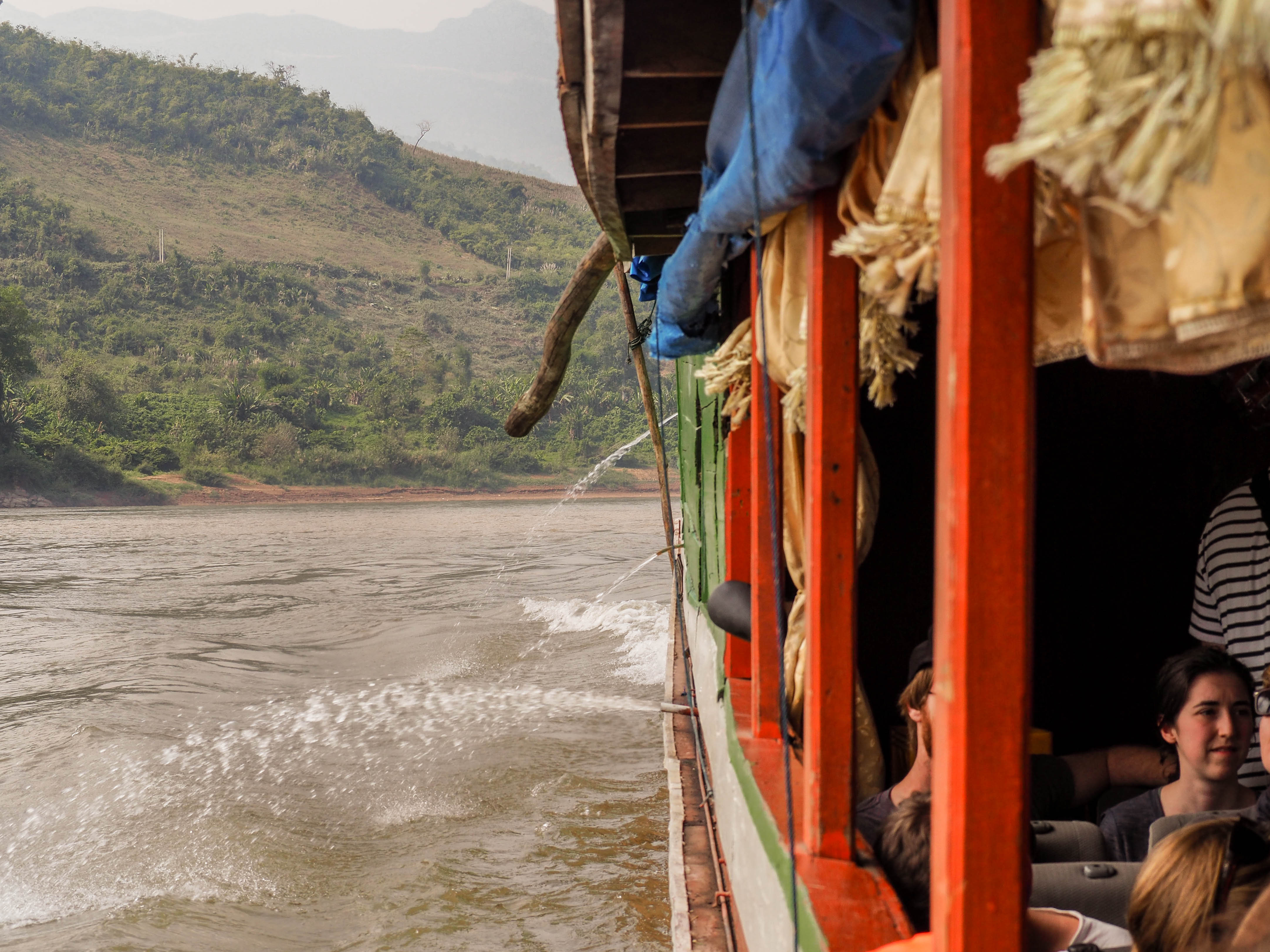
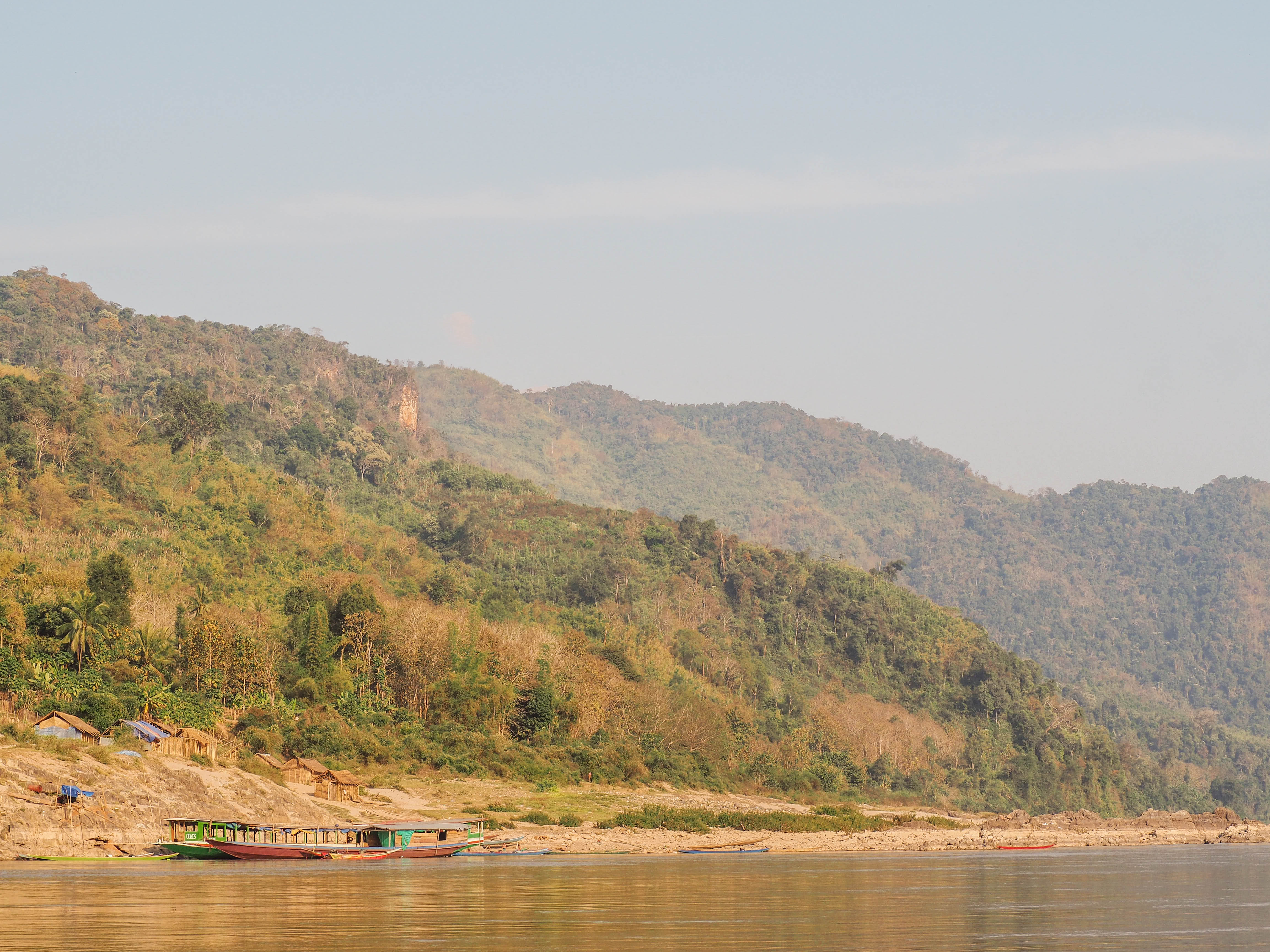
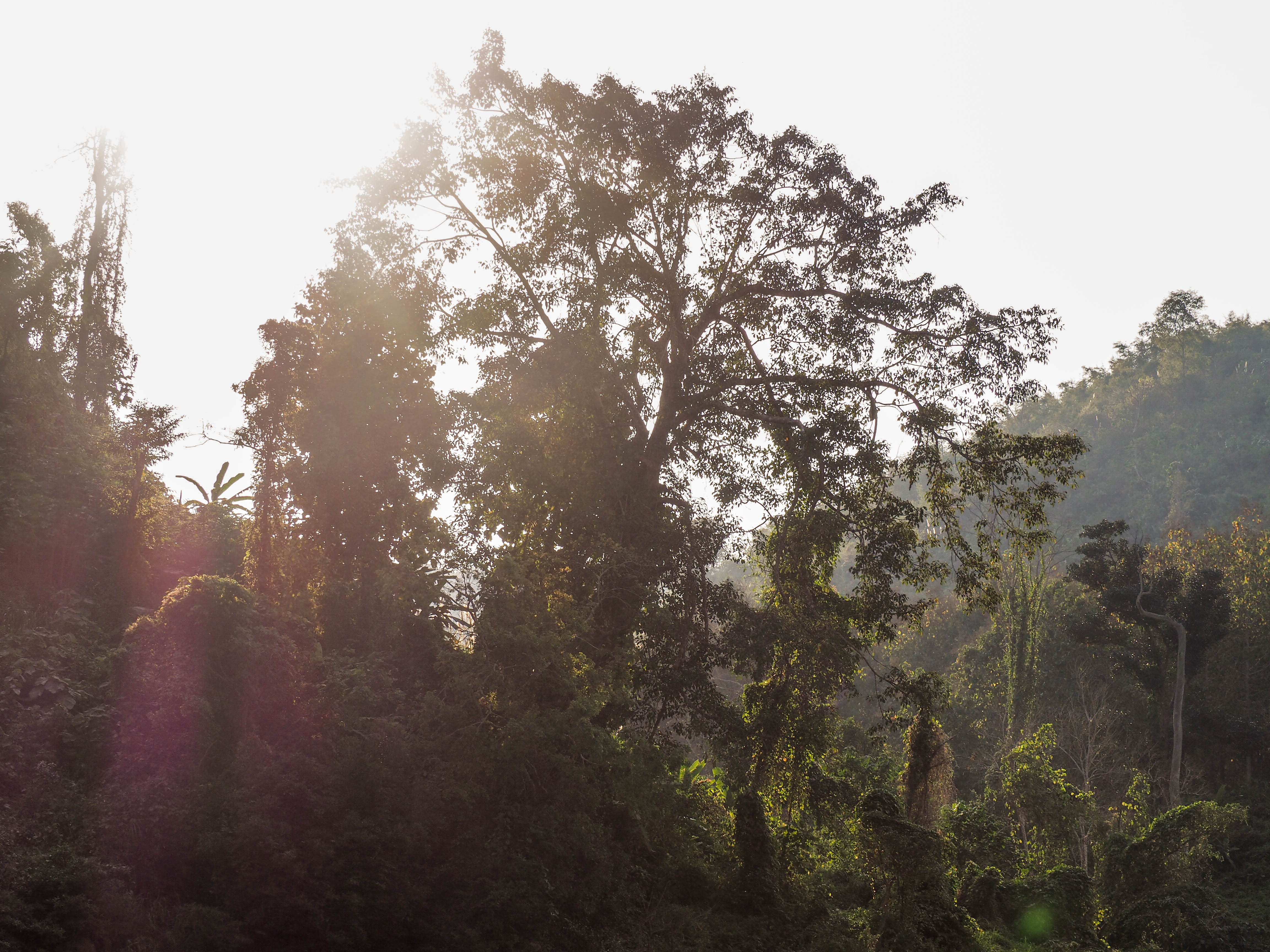
Pak Beng
At around 5:30 PM you’ll arrive in Pak Beng, where you can immediately arrange for accommodation at the pier. Expect shitty fan-rooms with gecko’s on the walls and cockroaches in the bathroom. If you want something more luxurious – opt for the eco-friendly the Sanctuary Pak Beng Lodge with beautiful and clean rooms and a killer view overlooking the Mekong River from its restaurant.
After dinner, all travelers that are looking for some social interaction gather at either Happy Bar or the Hive Bar, where drinks are served and tunes are pumped well over midnight.
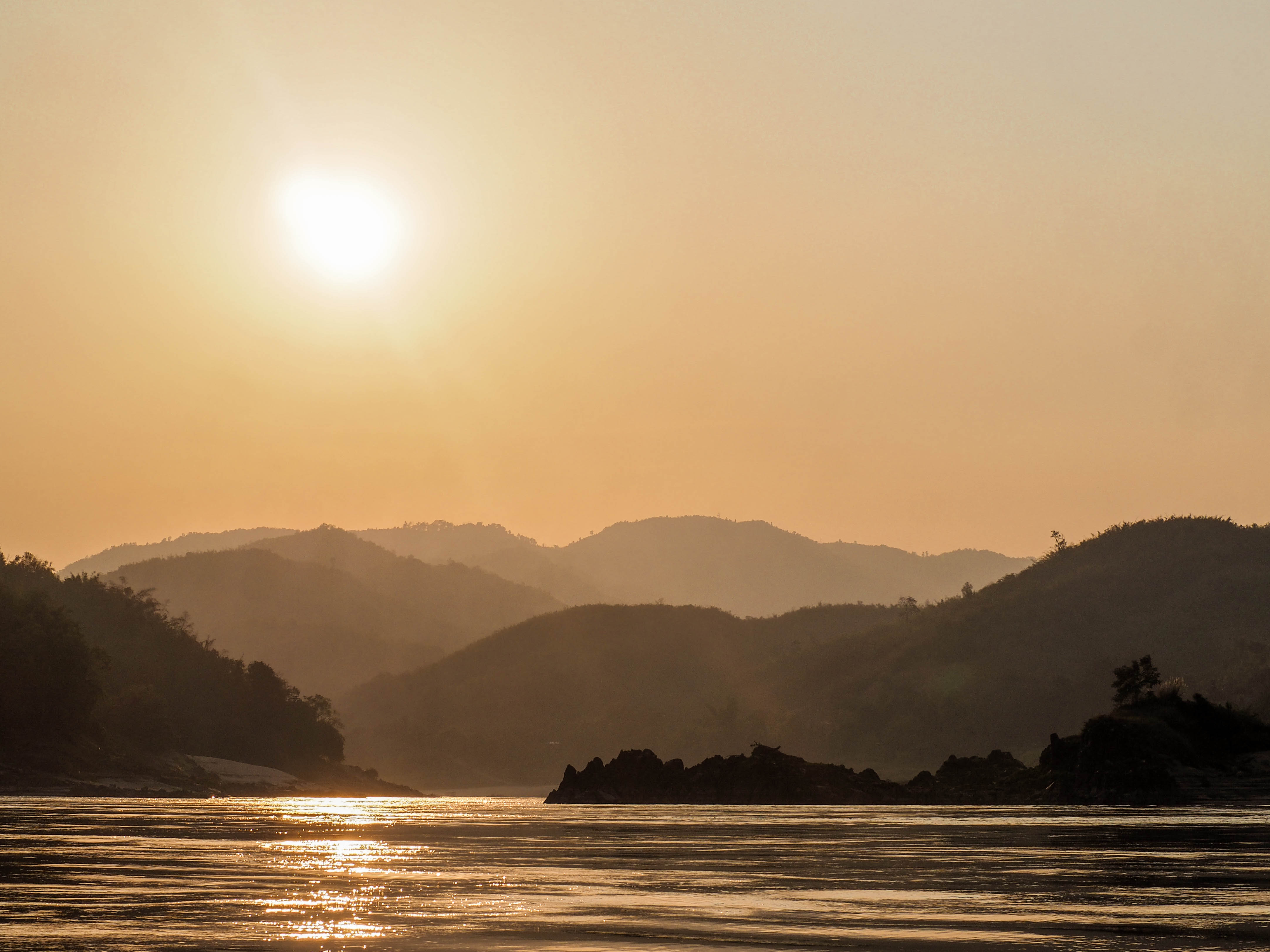
Day two
The next morning the boat to Luang Prabang leaves at around 09:00 AM. Most people – especially those who spent their first day in the engine room – will arrive early and the boat will most probably fill up before 08:30 AM. Luckily this time everybody is divided up over 3 boats that are both more comfortable and more spacious. I have no clue why these boats aren’t used for the first lap but I can image it is because shallower water does not allow for the big boat to go to Luang Prabang. Obviously the smaller, more comfortable boats are more costly for the operators. Either way, this part of the trip is more relax and enjoyable. In my experience, people are also a bit less social most probably because they are no longer cramped together with 10 people in one square meter.
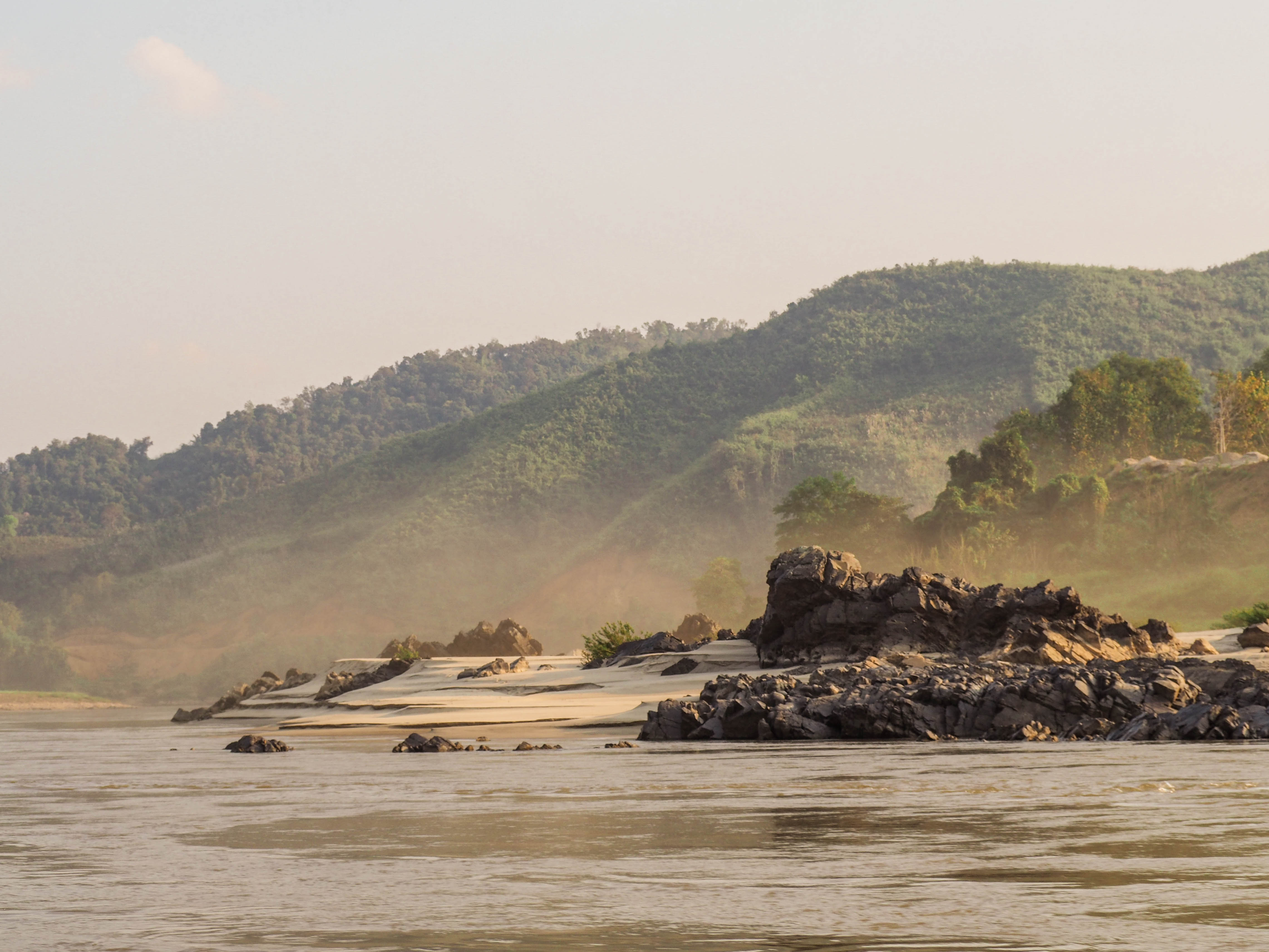
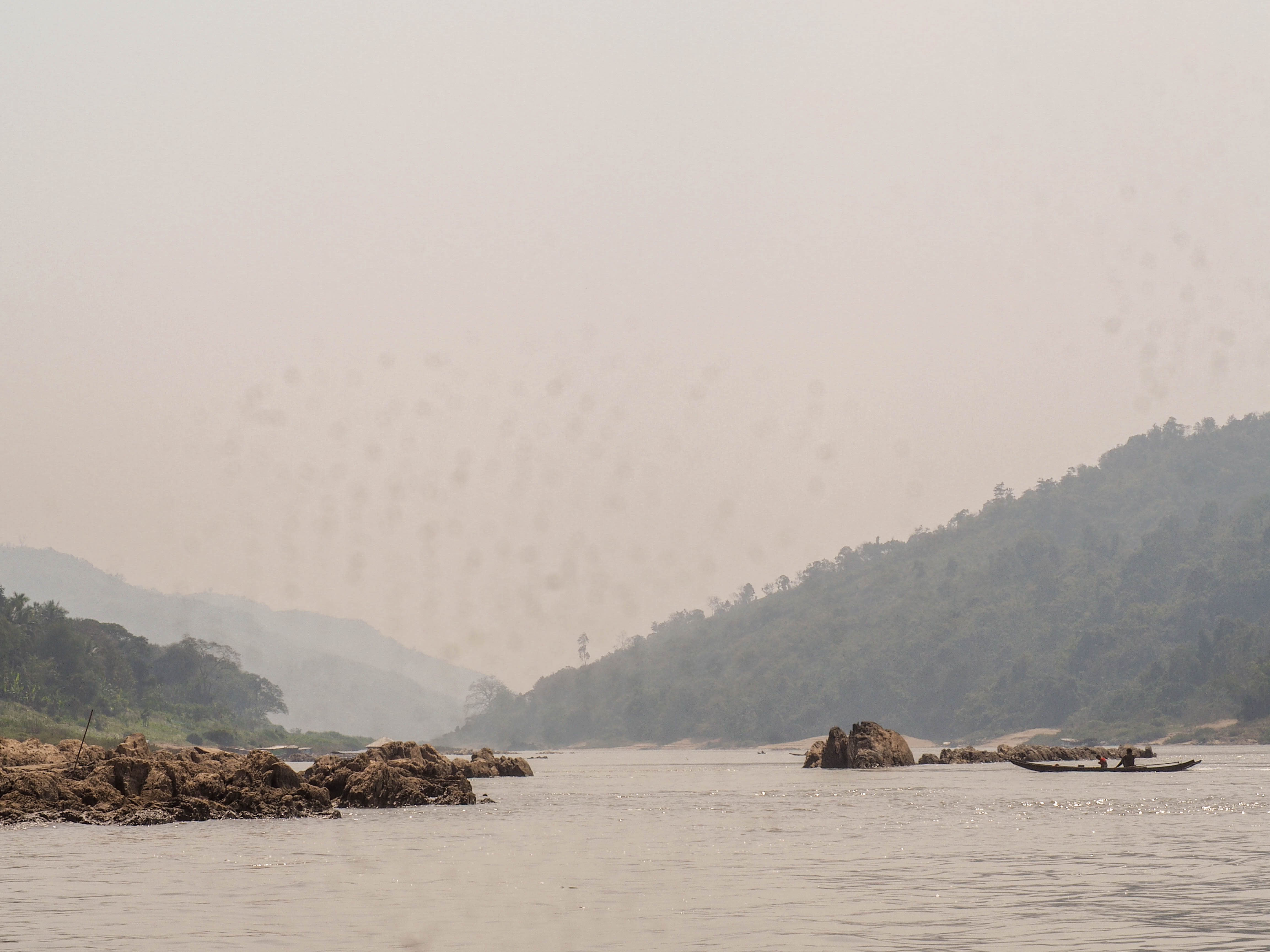
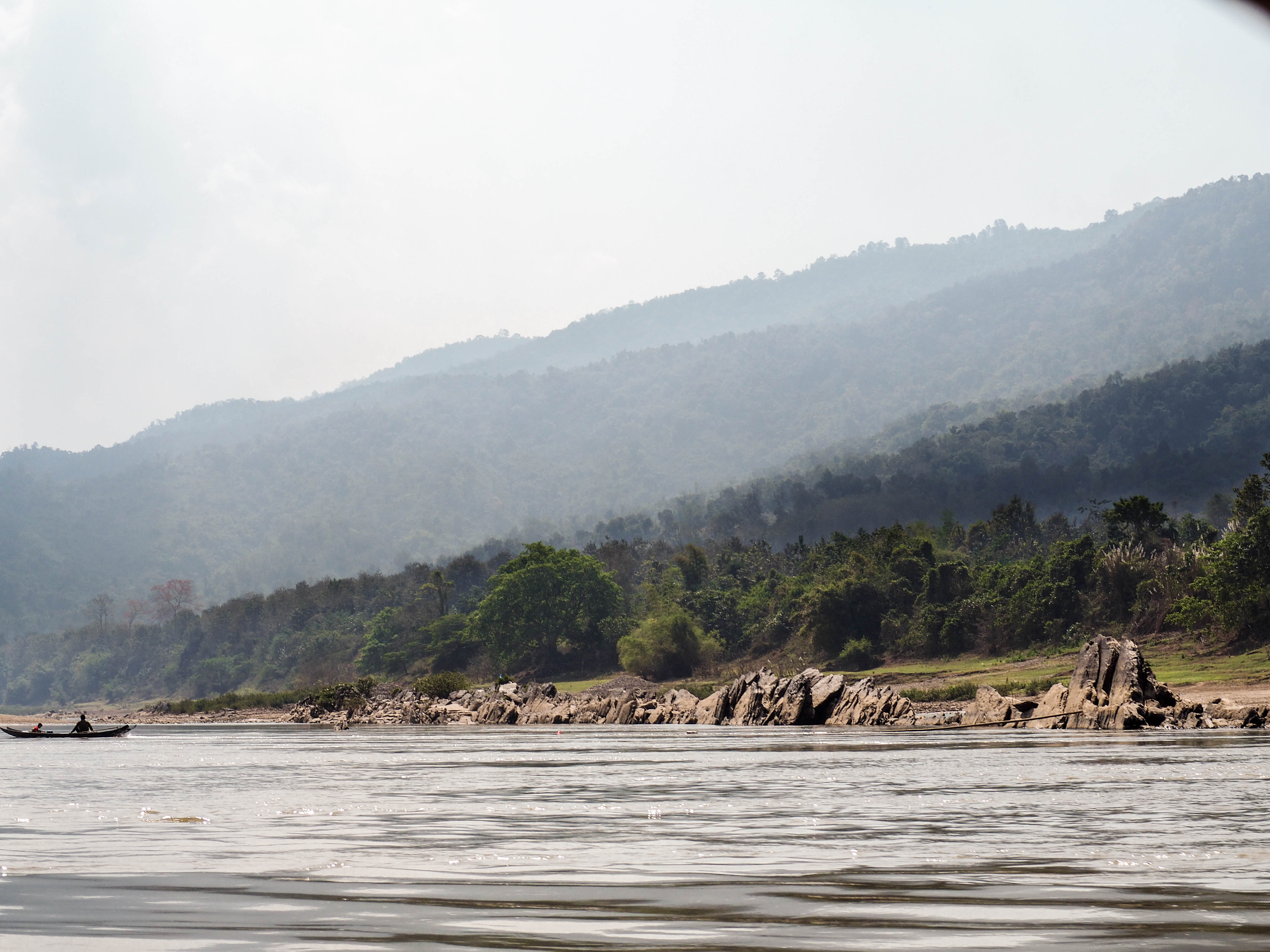
At around 04:00 PM you arrive at the Luang Prabang tourist pier where you have to get off and take a tuk-tuk into town. Here, everybody cues up to buy a ticket (20K kip) into town.
If you gather a large enough group you do not need to buy a ticket and can just arrange for a tuk-tuk to take you to your accommodation straight away – saving you time, hassle, and if you are a good barterer probably a bit of money as well.
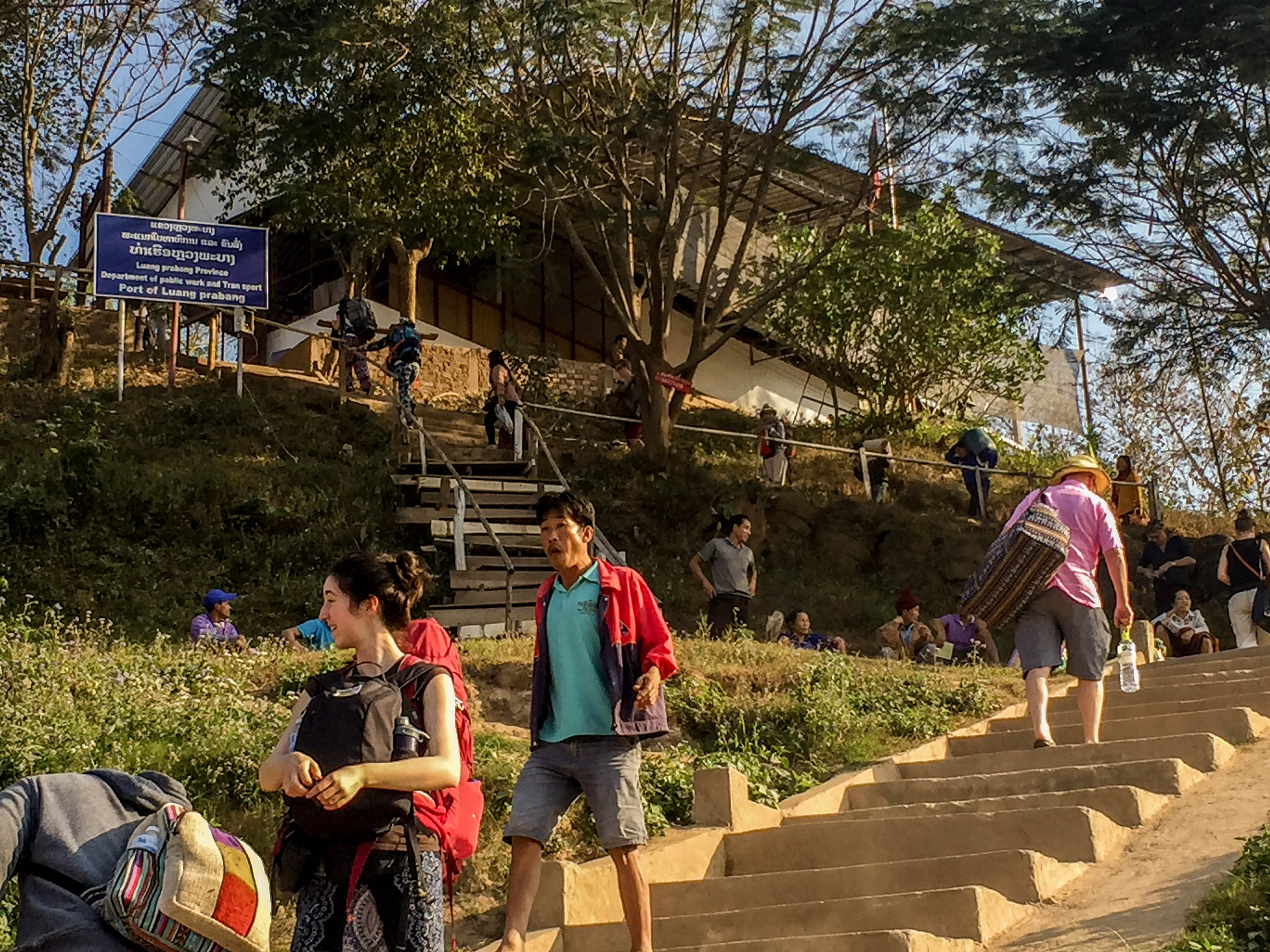
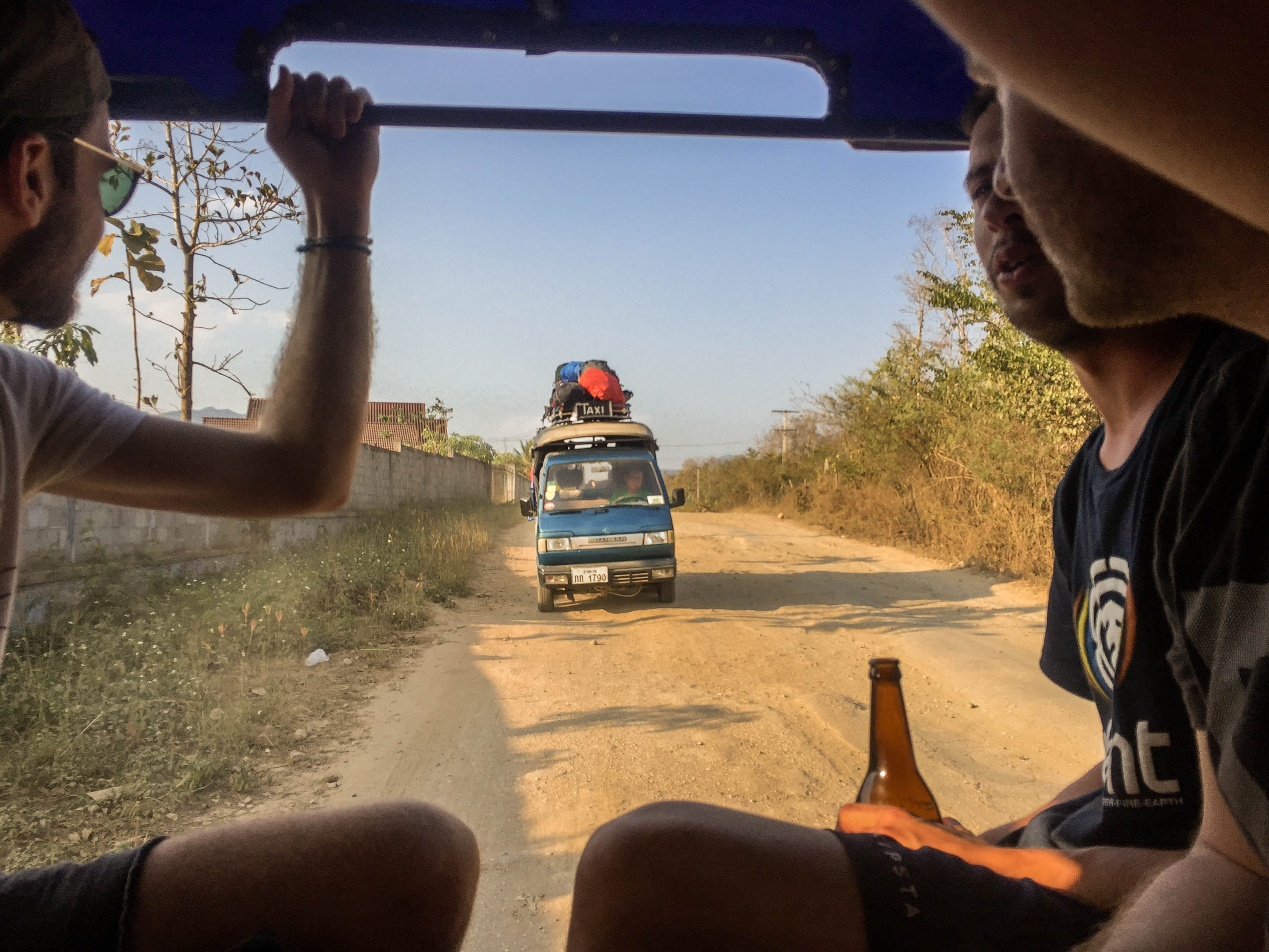
Bangkok’s trendiest neighbourhood: Ari
When people are planning a trip to Bangkok they usually stay in the same areas. Backpackers choose Banglamphu where they can party all night long on the infamous Khao San Road, people with a little more to spend head over to Sukhumvit with its trendy clubs, restaurants, and fancy hotels. Lastly, business travellers opt for the financial district Silom, with even more fancy restaurants and even bigger hotels. But Bangkok’s got more up its sleeve. If you are looking for chill vibes, hip eateries and easy connections to all the highlights the city has got to offer it is worth considering staying in Ari, the hippest ‘up-and-coming’ neighbourhood in Bangkok.
